Archaeologia Lituana ISSN 1392-6748 eISSN 2538-8738
2019, vol. 20, pp. 40–74 DOI: https://doi.org/10.15388/ArchLit.2019.20.3
AMS 14C Dating of the Cremated Human Bones and Funeral Fuel of the Western Balts. In Theory and in Practice
Roman Shiroukhov
Centre for Baltic and Scandinavian Archaeology (ZBSA),
Stiftung Schleswig-Holsteinische Landesmuseen, Schloss Gottorf
Schleswig, Germany
roman.shiroukhov@zbsa.eu
Abstract. The article is dedicated to the application of AMS 14C dating method of cremated bones and samples of related charcoal, which is rather new for the East Baltic region. The data of 3 Western Balts cemeteries from Lithuania are analysed. Results of radiocarbon dating are compared to the estimated typological chronology of the artefacts. The OxCal simulation is applied in order to obtain the most probable dates. The study lays the foundation for further spatial and static analysis of selected data.
Keywords: AMS 14C dating, cremated bone, bioapatite, charcoal, OxCal functions, relative chronology.
Vakarų baltų degintinių kapų kaulų ir anglies AMS 14C datavimas: teorija ir praktika
Anotacija. Straipsnis skirtas degintinių (kremuotų) kaulų ir su jais susijusių anglių mėginių AMS 14C datavimo metodo pritaikymui Rytų Baltijos regiono archeologinėje medžiagoje. Analizuojami trijų Lietuvos teritorijoje esančių skalvių ir kuršių kapinynų AMS 14C datavimo rezultatai, kurie lyginami su radinių tipologine chronologija. Modeliuojant tikėtiniausias datas naudojamas OxCal simuliavimas (fazių funkcijos). Tyrimas sudaro pagrindą tolesnei pasirinktų duomenų erdvinei ir statistinei analizei.
Reikšminiai žodžiai: AMS 14C datavimas, degintiniai kaulai, bioapatitas, anglis, OxCal funkcijos, santykinė chronologija.
Received: 25/10/2019. Accepted: 12/12/2019
Copyright © 2019 Roman Shiroukhov. Published by Vilnius University Press
This is an Open Access article distributed under the terms of the Creative Commons Attribution Licence, which permits unrestricted use, distribution, and reproduction in any medium, provided the original author and source are credited.
Introduction
Accelerator mass spectrometry method (AMS) has only recently begun to be used to date the archaeological materials of the Balts. The burial rites of the Western Balts of the Late Iron Age remain conservative and are represented generally by cremation graves with a few variations of local forms. On the other hand, the burials of the Western Balts reflect dynamics of chronological change in grave goods, accompanied by organic remains: cremated bones and charcoal. A source of their carbon defines the time of cremation and so of construction of the sealed deposit.
Iron Age chronology of the East Baltic region today is still more intuitive than relative, mostly based on typological dating of sequences of grave goods. The main problem of each cemetery’s chronology lies in the field of correlation and compatibility of three dates: the date of creation of the deposit (or cremation), the date of the existence of a type and the date of use of a certain artefact. These will be discussed below in some detail.
The Western Balts Late Iron Age cemeteries data give an opportunity to establish a new combination of dating methods for this area, applying typology, GIS, Statistics and 14C. The study represent some preliminary results of the author’s Alexander von Humboldt Foundation (AvH) project „New dating approaches for the Late Iron Age of the South-East Baltic Region“. The territory of research: Kaliningrad region of Russia and South-West Lithuania. Initially the data of 9 Prussian, Curonian and Scalvian cremation cemeteries (about 800 graves) is used. Archaeological sources of the Western Balts provide a good opportunity for chronological studies. A combination of local and imported goods within the same cremation graves allows a comparison of the relative dating of the local goods with imports both from the West and the East of Europe. First of all, that is rather characteristic for the Prussians, whose military elite cremation graves of the period often may offer a Kievan Rus’ slate spindle and “Hanseatic” bronze bowl found together with other goods of trade (Shiroukhov, 2012, p. 226–233). The relative-dating part of the project is about the correlation between the possible date of the process of cremation and the typo-chronology of each 14C dated sealed deposit. Mainly the metalwork-based chronological schemes are used. GIS, as the tool of georeferenced past visualization, places the typological data of cemeteries on multi-layered time maps. Then typological georeferenced data are statistically analysed, using correspondence analysis with R software. GIS and statistically verified relative chronology is compared with the AMS 14C absolute dates of the samples from the relative-dated graves (Shiroukhov, 2018, p. 62–63; 2019, p. 27–28; Широухов, 2019, c. 212–213).
Within the frameworks of the AvH Project more than 50 samples from 7 cemeteries were successfully dated at the Leibniz Laboratory for Radiometric Dating and Stable Isotope Research of the Christian-Albrechts-University of Kiel (KIA). The most stable material for radiocarbon dating turned out to be the mineral (bioapatite) part of cremated human bones. The results of AMS 14C dating of 21 samples from 3 cemeteries are presented in this article: Viešvilė I, Lazdininkai and Palanga (all in West Lithuania) traditionally connected to historical tribes of Scalvians and Curonians (Fig.1).
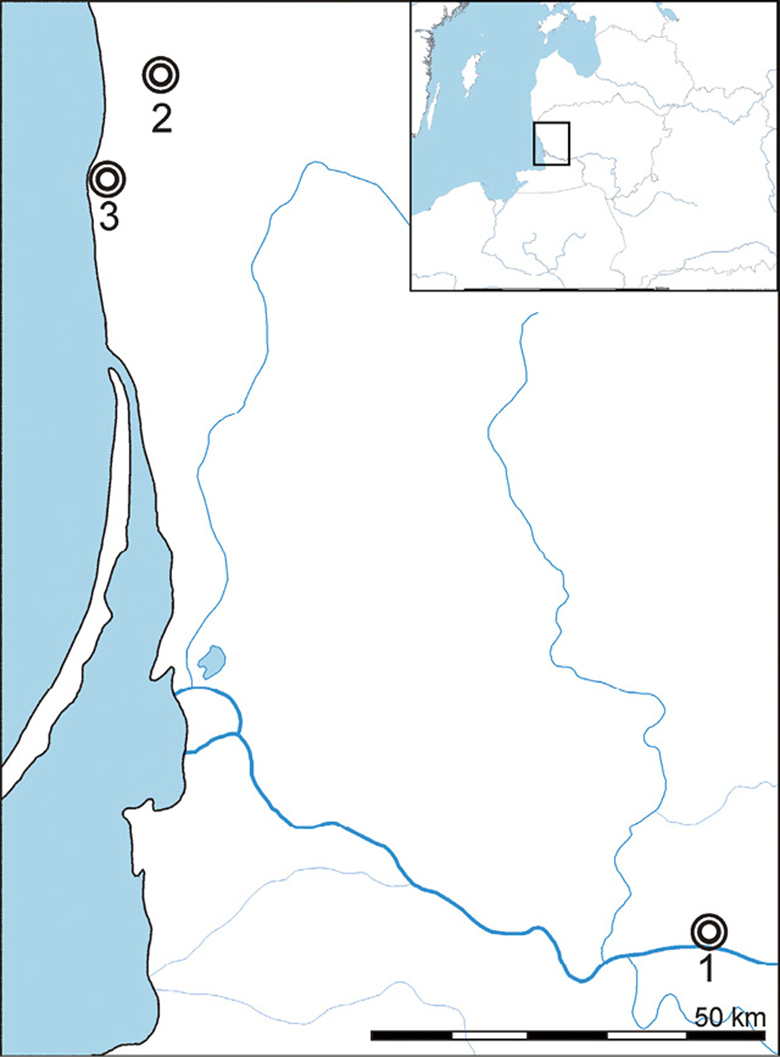
Fig. 1. Sites represented in the study. 1. Viešvilė I; 2. Lazdininkai; 3. Palanga. (Drawing by R. Shiroukhov).
1 pav. Tyrime nagrinėjami archeologijos paminklai. 1. Viešvilė I; 2. Lazdininkai; 3. Palanga (R. Širouchovo piešinys)
History of 14C dating of cremated (calcined) bones
Systematic successful dating of the mineral composition of cremated bones has a relatively short history. As the method of dating of bioapatite of cremated bones is rather new in Baltic archaeology, it is useful to consider its development. The starting point for effective dating of cremated bone is the collective article by J. Lanting, A. Aerts-Bijma and H. Van der Plicht “Dating of Cremation Bones” (Lanting et al., 2001). It was the first working attempt of pre-treating cremated/calcined bone to enable radiocarbon dating. Before this, it was considered impossible to date cremated bones (Fitzpatrick et al., 2017, p. 363). Necessity at the time to date the wood charcoal rather than cremated bone lead to relatively large error ranges and resultantly long calibrated date range of several hundred years (Garrow et al., 2014, p. 209). Which is insufficient for “historical” archaeology. First of all because of wood-age offsets discussed below.
During the following decade studies confirmed the success of dating the mineral component of the cremated bone. This led to the creation of a more accurate radiocarbon scale for the North Europe region, including the UK. To explain the process of bone transformation in general, the changes occurring during cremation lead to the loss of organic carbon (found in bone proteins and lipids). Biomineral carbonate in bioapatite is apparently replaced during recrystallization as the bone cools down. When bones are heated to above 600°C, the bone-osteocalcin (apatite) is converted to structural carbonate, which can be dated1. The structural carbonate is very resistant to change and not easily contaminated once cremation has occurred, therefore it has been shown to be a good substance for reliable AMS 14C dating. In practice it is needed to sustain temperatures of over 600°C for several hours to cremate the corpse. When heated, all organic matter in bone is destroyed and the only carbon within the carbonate fraction of bone apatite remained. After cremation, the structural carbonate is rebuilt with new carbon from the pyre atmosphere, which makes it possible to date an “event”2 – the approximate “moment” of cremation itself. Nevertheless, it is still difficult to ascertain the origin of the carbon left in bone apatite after calcination (Strydonck et al., 2005; Zazzo et al., 2009; Hüls et al., 2010; Snoeck et al., 2016, p. 33; Fitzpatrick et al., 2017, p. 364).
Post depositional contamination of well-cremated bones seems to be limited, and makes it less susceptible to contamination from burial environment. But perception of what sources of contamination might still be present. Which is relatively easy to remove, because the calcite is much more soluble in weak acids than apatite. (Styrdonck et al., 2010, p. 578; Agerskov Rose et al., 2019, p. 1).
The largest number of publications on the successful dating of the carbon source of calcined bones belongs to the last decade. These involve case studies with comparative experiments, using a new material, and work with the establishment of possible third-party (fuel, age) effects on the dating of cremated bone, including the “old wood effect”. Including the research on the nature of the metabolic processes between the fuel of cremation and human remains. The possibility for exchange has been demonstrated using both controlled laboratory cremation and small real-world experiments on joints of animal meat. Many of referenced below publications also assume the resistance of calcined bones to external influences after cremation and the creation of a closed deposit. Which confirms further the reliability of the dating of this material (Strydonck et al., 2010; Zazzo et al., 2012; Bayliss et al., 2013; Olsen et al., 2013; Mays et al., 2013; Garrow et al., 2014, p. 209–220; Fitzpatrick, 2017, p. 364).
The look and condition of the most of the cremated bones samples used in the study – well burned, fully calcined bones of a uniformly whitish colour, also facilitates the process of dating. Careful selection of well cremated bones is essential for reliable adequate AMS 14C analysis (Mays et al., 2013, p. 7–8; Olsen et al., 2013, p. 31; Snoeck et al., 2016, p. 33; Agerskov Rose et al., 2019, p. 2).
The samples were pre-treated according to the KIA Protocol and calibrated in OxCal software using the internationally agreed IntCal13 calibration curve. The radiocarbon ages are translated to calendar ages using the software package OxCal 4.3.2 and the IntCal13 dataset. Cremated bones were pretreated using an acetic treatment. To remove secondary calcite, the bone material (usually 1,5–2 g. piece) was first crushed and treated five times with 0.1M acetic acid at room temperature to remove any calcite, rinsed with H2Odem several times, and dried. The cleaned material is further titrated with HClconc until about 50% of the material is dissolved. After washing, drying and weighing, the sample was reacted with 60% phosphoric acid (85°C) to produce CO2. CO2 is liberated from the remaining sample material with 60% phosphoric acid at 65°C. To remove any sulfur compounds, the sample gas (CO2) was sealed in a quartz tube with CuO and silver wool and heated for 4 hr at 900°C. The purified CO2 was reduced at 600°C using H2 and iron powder as catalyst and then pressed into targets for AMS measurements. Charcoal samples were pretreated with a leaching treatment, using alkali residue. Samples were checked under the microscope and an appropriate amount of material is selected for dating. The selected material is subsequently extracted with 1% HCl, 1% NaOH at 60 °C and again 1% HCl. (Hüls et al., 2010; Reimer et al., 2013; Agerskov Rose et al., 2019).
The date of cremated bones bio-apatite reflects rather the “moment” of cremation, than a moment of death (as in a case of bones collagen derived from inhumations) of a person, not being influenced by the diet of the deceased and therefore – not subjected to the “reservoir effect”. But the radiocarbon dates of cremated bones are subject to wood-age offsets, as the carbon in cremated bones appears to be delivered mainly from the pyre fuel. Small wood-age offsets affecting the 14C dates of cremated bones cannot be also excluded based on typo-chronology (Garrow et al., 2014, p. 221; Agerskov Rose et al., 2019, p. 7). So, what about charcoal?
Cremated bones, charcoal and “old wood effect”
First, it is important to establish the origin and the age of the charcoal in the cremation grave. There are not so many studies focusing on the fuel of prehistoric pyres. Most deal with firewood species identification, but not with the age of trees used for cremation (Strydonck et al., 2010, p. 583). The most important for this study are recent works on the origin of cremation charcoal by M. Moskal de Hoyo and L. O’Donnell (Moskal de Hoyo, 2012; O’Donell, 2016).
To know the range of the estimated 14C date offset of the same sample it would be useful to know the age of the source of the wood. Studies of charcoal alongside osteological data on Irish Bronze age suggests that the selection of wood did not reflect the age or sex of the deceased. There is also little evidence that the wood charcoal taxa are hardly connected to the sex/age and degree of bone calcination. The comparison of charcoal to osteological data demonstrates, that the same types of fuel were used for different members of society (O’Donnell, 2016, p. 161, 165, 170). It means that the age and social status of the deceased are hardly connected to the age of the wood used for the cremation.
The gathering of the different sorts of wood: trunk-parts, branches or twigs (including deadwood) was based on the simple availability, with the least possible effort made during its collection. The presence of different parts of wood on different Iron age Poland cremation cemeteries suggests the use of all possible fuels for the pyres, with the wood of different diameters presented. It is hard to distinguish also the woods of freshly cut trees from those that were stored prior to their use. Remains of the trunks suggest the use of stored wood, while evidence of the branch wood is indicative of young wood gathered shortly before the cremation (Moskal del Hoyo, 2012, p. 6–9).
What about the connection of potentially old wood to the AMS 14C dating results of cremated bone? Recent studies demonstrated that a modern bone would acquire an old radiocarbon age if cremated in an artificial atmosphere in which the carbon dioxide came from geological sources. They also show that if an archaeological bone is cremated in modern firewood, it would acquire a modern radiocarbon age (Hüls, 2010, p. 597; Zazzo et al., 2012, p. 863). In the case of a normal ritual cremation, the difference in the 14C content of the cremated body and the fuel will in most cases be minimal and a possible carbon exchange will be difficult to recognize (Strydonck et al., 2010, p. 578; Olsen et al., 2013, p. 33). The latest experiments show that the carbon in the bioapatite is largely replaced during cremation with carbon from the pyre atmosphere, which is why the wood-age of the fuel used in cremation can theoretically be incorporated in the radiocarbon date of the bioapatite of the bone (Hüls, 2010; Zazzo et al., p. 2012). This means that the radiocarbon dating of cremated bones potentially is equivalent to the dating of the wood used for the cremation fire.
Despite comparable14C ages has been obtained by paired samples of associated charcoal and cremated bone samples (Lanting et al., 2001; Van Strydonck et al., 2005, p. 4–9; Snoeck et al., 2016, p. 32), this opens the possibility of the old wood effect for radiocarbon-dated cremated bones (Olsen et al., 2013, p. 31). Judging by the above publication on the source of the pyre fuel, the possible effect of using old wood in the cremation fires is probably limited and not easily recognized as also demonstrated by the numerous tests on paired samples of cremated bones and associated context materials (Lanting et al., 2001; Strydonck et al., 2005; Olsen et al., 2013, p. 34). In summary the carbon present in calcined bone apatite is comprised of a combination of endogenous bone apatite carbonate, endogenous collagen carbon and fuel carbon. Majority of carbonates present in bone apatite after cremation originates for the fuel used in the pyre. (Snoeck et al., 2016, p. 40–41).
In several cases it can be proven, that old wood was used for the cremation pyre. It can be such indirect evidences as the traces of fungus in wood and the occurrence of iron nails, fittings and other external objects, which strongly suggest that some wooden objects were reused as fuel (Fitzpatrick, 2017, p. 364). The occurrence of ship rivets and possible reuse of ship wood (wrecks) in post-Viking age cremation graves of Prussians is a case worthy of special attention. Old timbers could have been used for purely functional reasons, to fulfil the need for a slow burning fuel to transform the body, but it also possible that old timber, for example from buildings (or ships) was deliberately incorporated into the pyres (Fitzpatrick, 2017, p. 377).
Attaching any error to charcoal dating using old wood is obviously impossible, since it is non-systematic. Thus, taking into account the possibility of an effect of “old wood” of charcoal, the dating of cremation bones is a priority. That is why it’s necessary to compare results of the dating of cremated bone and charcoal samples of the same object, wherever possible. This study demonstrates both the possible impact of old wood effect on a cremated bone sample and the synchronous cremated bone and charcoal dating results. It is important also that the chemical composition of well cremated bone confirm the high resistance to post-burial alternations (Snoeck et al., 2016, p. 42).
Ams radiocarbon dating of the South-East Baltic Iron Age
Organic remains of the Western Balts Iron Age sites have rather short history of radiocarbon dating. One of the first systematic attempts was N. Krenke and M. Pevzner’s radiometric (GIN and Ki) and AMS 14C (KIA) dating of the more than 30 samples of charcoal, charred earth and wood from Sambian Prussians settlements Kulikovo 8 and 8A and the hill-fort rampart of Diewens/Romanovo. 14C dates of this study represent sealed deposits consisting of settlement pits, or cumulative-sealed deposits – wells. Most of the dates correspond to the expected typo-chronological range, with some extents (Кренке et al., 2010, p. 150–159, Tab. 1.).
Next step of the systematic radiocarbon dating of the Western Balts fortified settlements, is the research of West Lithuanian Apuolė hill-fort by T. Ibsen. The study is based on the AMS 14C dating (KIA) of charcoal, extracted by geological drilling from the layers of the hill-fort structures, which gave a wide range of dates, including several 14C dates corresponding to the Baltic Late Iron Age (Ibsen, 2018, p. 253–259, Abb. 9–10, Tab.1).
14C dating results of charcoals from two studies mentioned above could be used to compare the results of radiocarbon dating of cremated bone, charcoal and other samples from Western Balts cemeteries of the period, using sealed deposits with the similar types of ceramics. What’s about 14C dating of the Balts cemeteries data?
Several publications on this topic deserve special attention. First of all, one of the last articles of L. Kurila “AMS 14C Dating of the Human Bones from East Lithuanian Barrows: Results and Perspectives” (Kurila, 2015). 30 samples, mainly human bones from 20 East Lithuanian barrow-mounds (11 of inhumations and 19 of cremations) were selected for this study and dated by the Poznań Radiocarbon Laboratory (Poz) (Kurila, 2015, p. 47, Lent.1). Most of gained results gave the date range chronologically wider than the context of the graves or inappropriately old dates (Kurila, 2015, p. 69–72; Bliujienė et al., 2017, p. 698) The first problem of this study is the use of slightly burned (charred, instead of well-cremated) bones in the case of cremation graves (Kurila, 2015, p. 63). As discussed above, changes occurring in the process of cremation lead to the loss of organic carbon, which is replaced by carbon from the atmosphere of the cremation. But only in the case when bones are heated above 600°C, the bone-osteocalcin (apatite) is converted to structural carbonate, which can be dated. So, the “compactness” of well-cremated bones forms a barrier to contamination, that does not exist in the case of burnt or charred bones (Strydonck et al., 2010, p. 578). In the case of East Lithuanian barrow-mounds collagen of burnt skeletal remains, instead of bioapatite of cremated bones, was extracted for dating. In a contrast to well-cremated bones features, the burnt bone collagen is unstable and the bioapatite part is not fully developed3.
L. Kurila sees the main reason of the incompatibility of typological and AMS 14C dates of human bones in the impact of a diet on human skeletal remains (fresh water reservoir effect) (Kurila, 2015, p. 70, 73). The old wood effect here could be taken only in a case of cremated bones. But the last is reflected only through the dating of bio-apatites of the well-cremated bones, not of the burnt/charred ones. Yet it seems, that the main problem of this generally thorough and systematic research include the initially wrong selection of material and thus the dating of the unstable component (in the case of cremation graves). In other world bioapatite represents the only possibility for isotope analysis of calcined bone (Snoeck et al., 2016, p. 32).
One of the latest examples of the radiocarbon dating of the Western Balts cemeteries is A. Bliujienė and R. Bračiulienė study of the West Lithuanian Užpelkiai cemetery, associated with Memel-Klaipėda/Niemen culture or historical Curonians (Bliujienė, Bračiulienė, 2018). Authors of the monograph date 16 samples of the charred wood, charcoals, horse bones and meal-remains from the inner surface of the household pots of the Roman Age – Early Medieval/Late Iron age cremation graves and horses burials/sacrifices (Bliujienė, Bračiulienė, 2018, p. 191). Cremated human bones unfortunately were not dated. Most of the dates were obtained at Poznań laboratory (Poz), and in two another laboratories in Vilnius (FTMC, Vs) and in Kiev (Ki) (Bliujienė, Bračiulienė, 2018, lent. 18). The dating of horses remains (tooth, skull parts) from Užpelkiai and 2 other cemeteries revealed the unsystematic nature of this material. Another collective study with 14C dating of horses remains from Lithuania confirms that some results are fitting into typo-chronological framework, while the most of dates are too old or unsystematic (Bliujienė et al., 2017, p. 696–702). Taking into account the consistent results of dating of horse remains from Sambian peninsula within the mentioned AvH project of the author4, the reason for this could be the traces of conservation of the remains (which is emphasized by authors) or the lack of direct connection between the horse tooth and the grave.
The use of some wooden fragments, judging by the description of their find context, is also not appropriate for AMS 14C dating. Authors of „Užpelkiai“ monograph take this possibility into account (Bliujienė, Bračiulienė, 2018, p. 193–194). Therefore, most of the obtained AMS 14C dates here are unsystematic and do not correspond to the typological dating (Bliujienė, Bračiulienė, 2018, p. 194–195). Where is the cause of error? Partially in a choice of laboratories with insufficient experience in dating such material. And probably due to the inaccurate selection of material for dating and partial use of already restored/conserved samples. In sake of experiment, it would be promising to date the cremated bones from Užpelkiai typologically confirmed graves.
The next study to mention here is the collective monography of M. Kazanski, E. Zalcman and K. Skvorcov dedicated to the Migration Age – Early medieval North-Sambian (Prussian) cemetery Zaostrovje-1 (Казанский et al., 2018). Authors dated charcoals and charred earth from 11 Migration Age-Viking Age graves in the laboratory of the Geological Institute of RAS (GIN) and Kiev (Ki). Despite some later radiometric 14C dates (comparing to typological dates), the authors emphasize the systematic approach of radiocarbon dating in the case of Zaostrovje-1. For example, all 3 Viking Age 14C-dated graves are located within the same area of the cemetery (Казанский et al., 2018, p. 27–28, Appendix 4), although the most of the dates obtained are too broad for the period considered here. The possible problem could be in use of the radiometric method and selection of laboratories giving dates with a high degree of uncertainty. Nevertheless, charcoal 14C dates of Zaostrovje-1 cemetery broadly correspond (with some extent) to the typological dating of the cemetery and form reliable chronological sequence (Казанский et al., 2018, p. 290).
Talking about previously discussed studies it would be useful to know more about sample selection procedure and the sources of carbon in samples (as charred earth, for example) the same as about relationship between the selected charcoal samples and the burials.
The first successful published systematic results of AMS 14C dating of the cremated bones of the archaeological culture connected to the Western Balts are given by P. Szymanski’s study of the Gołdap group burial mound 26 of the Czerwony Dwór cemetery, generally dated to the Migration Age (Szymanski, 2018). The burial mound 26 was represented by multi-layered structure with more than 30 individual burials, and was in use from the beginning of the 4th to the middle-end of the 6th centuries. 32 fragments of cremated bones, one piece of wood and charred fragments from the ceramics were dated in mentioned above Poznań laboratory (Poz). 21 cremated bones samples (from 32 gathered) received calendar dates, with a degree of uncertainty ± 30. The mineral part of bones, as “there were not collagen occurred” – bioapatites, was used for dating. This correspond to the modern state of research. Most of the obtained dates correspond to the relative (typological and stratigraphic) chronology of the separate graves and burial mound in general. In some cases, the 14C dates refine the typological dating (Gr. 121, 122), in another – give broader dates (Gr. 136 b, c) (Goslar, 2018, p. 245–247; Szymanski, 2018, p. 62–63, p. 111).
The results of successful systematic AMS 14C dating of the cremated human bones, horse teeth, charcoal, horn, textile and wooden fragments from the Late Iron Age cemeteries of the Western Balts within the AvH project of the author are partly represented by this article and are reflected in some conferences theses and annual reports of ZBSA (Shiroukhov, 2018; 2019; Широухов, 2019).
It is obvious that AMS 14 dating is not a panacea on its own and do not force to avoid other dating methods of archaeological data (Bliujienė, Bračiulienė, 2018, p. 195). 14C dates have to be verified and correlated, if possible, with other scientific methods of dating as, for example, GIS “time-mapping” and statistical techniques, implemented with R, Past or other software. It should be also not to be forgotten that the radiocarbon date is only a statistically estimated probability of a date. Though the 95.4% probability of the modern AMS dating is internationally accepted.
Dating the cremated bones and charcoal of the late Iron age Western Balts cemeteries
21 sample of cremated bones and charcoal pieces, connected to the Curonian and Scalvian cultures, dated within the frameworks of the author’s AvH project, are described in this study. There are 18 samples of cremated (calcined) human bone and 3 samples of charcoal from 18 cremation graves of 3 selected Western Balts cemeteries: Viešvilė I (Scalvians), Palanga and Lazdininkai (Curonians) (Table 1). In the case of 3 burials it was possible to date human cremated bone simultaneously with charcoal samples: Viešvilė I grave 19, Palanga gr. 267 and Lazdininkai gr. 35. The results of OxCal combination of these presumably synchronous dates will be discussed below.
From the very first glance all AMS 14C dating results of 3 cemeteries form systematic chronological sequences (Fig. 2). In general, all radiocarbon dates correspond to the spatial (planigraphic) and typological dating of the cemeteries. First the separate groups of dates from each cemetery will be discussed. After that three mentioned graves with simultaneously dated cremated bone and charcoal samples will be reviewed. And then I propose to consider in brief the use of the OxCal phasing function.
Table 1. List of radiocarbon-dated samples used in the study.
1 lentelė. Tyrime naudotų radioanglies mėginių sąrašas
|
Nr. |
Lab Nr. |
Cemetery |
Grave Nr. |
Sample |
Radiocarbon age (BP) |
Calibrated date, years (95.4% probability) |
Calibrated date |
|
1 |
KIA-53681 |
Viešvilė |
1 |
Cremated bone |
1106 ± 24 |
889–990 |
– |
|
2 |
KIA-53140 |
Viešvilė |
3 |
Cremated bone |
1051 ± 25 |
901–1025 |
953–1025 (89,3%) |
|
3 |
KIA-53679 |
Viešvilė |
5 |
Cremated bone |
1114 ± 24 |
886–988 |
– |
|
4 |
KIA-53141 |
Viešvilė |
13 |
Cremated bone |
1090 ± 25 |
893–1013 |
– |
|
5 |
KIA-53142 |
Viešvilė |
19 |
Cremated bone |
990 ± 26 |
990–1152 |
990–1051 (62,3%) |
|
6 |
KIA-53143 |
Viešvilė |
19 |
Charcoal |
1115 ± 28 |
780–995 |
875–995 (94,6%) |
|
7 |
KIA-53678 |
Viešvilė |
21 |
Cremated bone |
1122 ± 24 |
780–989 |
875–989 (94,5%) |
|
8 |
KIA-53145 |
Viešvilė |
22 |
Cremated bone |
1075 ± 25 |
896–1019 |
941–1019 (72,3%) |
|
9 |
KIA-53665 |
Lazdininkai |
35 |
Charcoal |
980 ± 18 |
1016–1050 |
11016–1050 (59,8%) |
|
10 |
KIA-53664 |
Lazdininkai |
35 |
Cremated bone |
976 ± 24 |
1014–1154 |
1014–1056 (44,5%), 1076–1154 (50,9%) |
|
11 |
KIA-53663 |
Lazdininkai |
36D |
Cremated bone |
910 ± 24 |
1036–1186 |
– |
|
12 |
KIA-53669 |
Palanga |
139 |
Cremated bone |
1036 ± 23 |
974–1028 |
– |
|
13 |
KIA-53125 |
Palanga |
173–174 |
Cremated bone |
971 ± 25 |
1016–1155 |
1067–1155 (56.5%) |
|
14 |
KIA-53670 |
Palanga |
184 |
Cremated bone |
987 ± 23 |
993–1151 |
993–1050(62,4%) |
|
15 |
KIA-53126 |
Palanga |
201 |
Cremated bone |
946 ± 26 |
1026–1155 |
– |
|
16 |
KIA-53671 |
Palanga |
248 |
Cremated bone |
935 ± 23 |
1032–1156 |
– |
|
17 |
KIA-53672 |
Palanga |
257 |
Cremated bone |
982 ± 23 |
997–1153 |
1011–1052 (52,1%), 1081–1153 (41,9%) |
|
18 |
KIA-53127 |
Palanga |
258 |
Cremated bone |
925 ± 26 |
1030–1164 |
– |
|
19 |
KIA-53128 |
Palanga |
267 |
Cremated bone |
947 ± 26 |
1026–1156 |
– |
|
20 |
KIA-53129 |
Palanga |
267 |
Charcoal |
948 ± 26 |
1025–1155– |
– |
|
21 |
KIA-53130 |
Palanga |
298 |
Cremated bone |
935 ± 27 |
1029–1159 |
- |
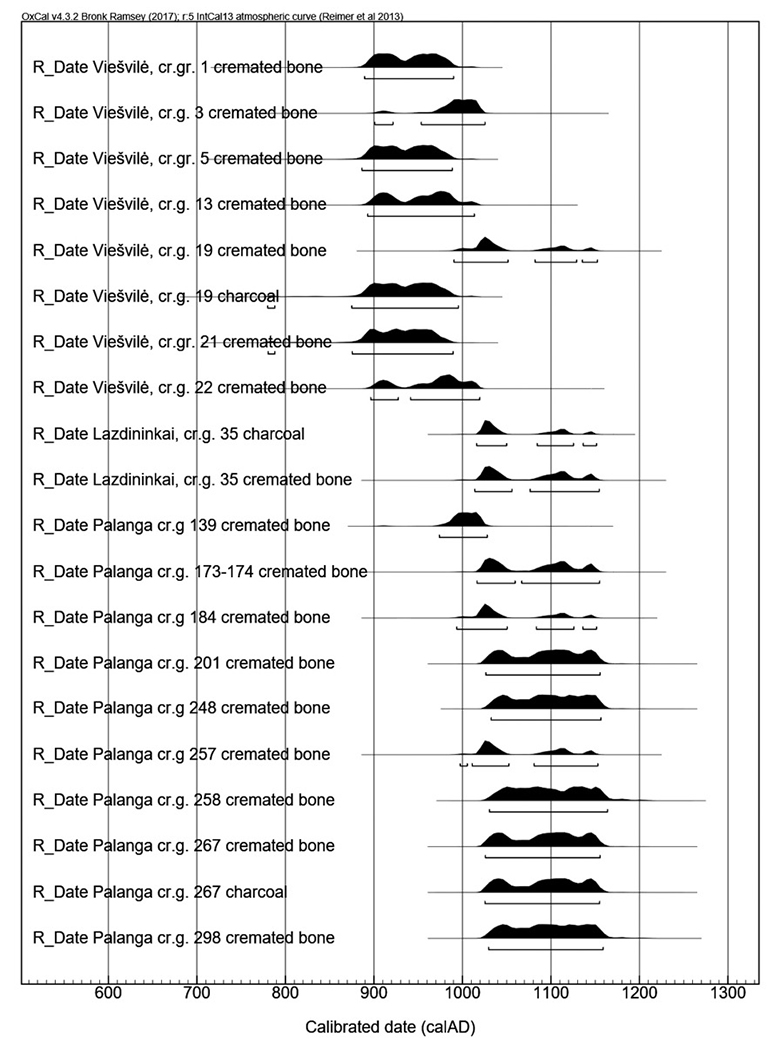
Fig. 2. Calibrated AMS radiocarbon dates of Viešvilė I, Lazdininkai and Palanga cemeteries, used in the study.
2 pav. Tyrime naudotos kalibruotos Viešvilės I, Lazdininkų ir Palangos kapinynų AMS 14C datos
Viešvilė I cremation graves
7 samples of cremated bone and 1 of a charcoal from Scalvian Viešvilė I cemetery were dated (Fig. 2, 3)5. One of advantages of this cemetery is availability of all contextual data, starting from the excavation documentation and artefacts, and ending with skeletal and other organic remains, well preserved and systematized. A substantial part of the graves short descriptions and artefacts were published (Budvydas, 2002; 2005; 2007a; 2007b; 2012, p. 132–137; 2016, p. 248–255). Viešvilė I skeletal remains are stored in Vilnius University Medicine Faculty Department of Anatomy, Histology and Anthropology. Charcoal, textile, leather and wooden remains are stored together with finds at Trakai History Museum (TIM).
It should be mentioned, that in contrast to Prussians, charcoal is rarely found within Scalvian cremation graves of the Late Iron Age, the same in general applies to Curonian cremation cemeteries. However, both Scalvian and Curonian cremation graves are represented by a higher degree of preservation and appearance (with appropriate chemical environment) of cremated bones: smooth well burned whitish fragments, giving systematic14C dates.
All gained AMS 14C dates of Viešvilė I give a span from the end of the 9th until the beginning of 11th century, with an obvious emphasis on the 10th century (graves 1, 5, 13, 21) and the second part of the 10th and beginning of the 11th centuries (gr. 3, 19, 22) (Fig. 2, Tab.1).
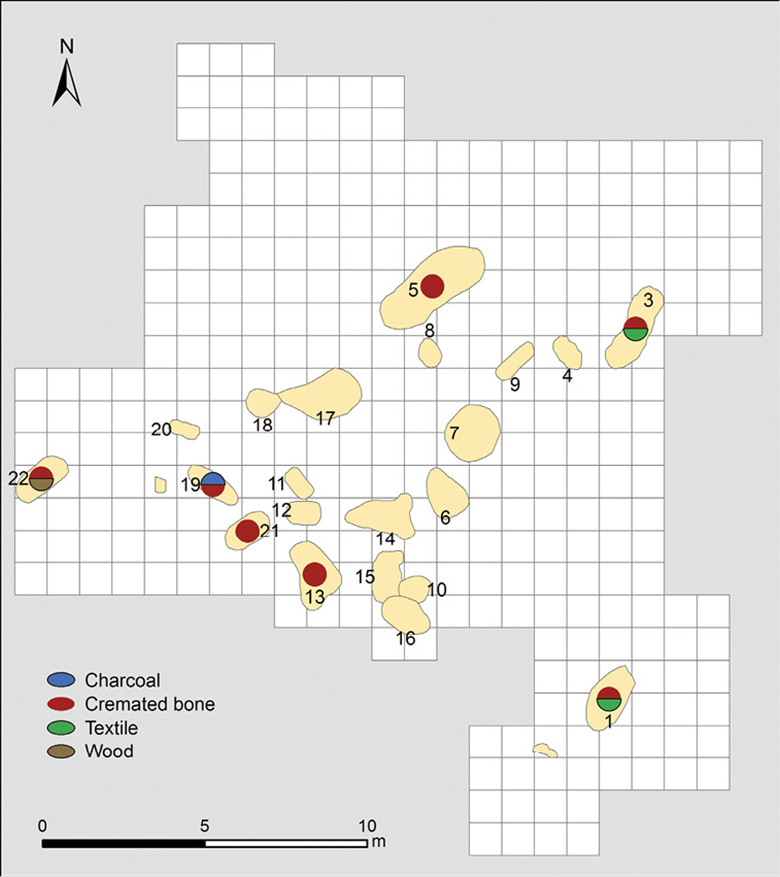
Fig. 3. Spatial distribution of Viešvilė I radiocarbon-dated samples of cremated bones and charcoal. (Drawing by R. Shiroukhov and K. Göbel after Budvydas, 2012, p. 133 and U. Budvydas archive).
3 pav. Viešvilės I degintinių kaulų ir medžio anglies AMS 14C mėginių erdvinis pasiskirstymas (R. Širouchovo ir K. Göbelio piešinys pagal Budvydas, 2012, p. 133, ir U. Budvydo archyvą)
Charcoal 14C date of grave 19 is visibly earlier than of human cremated bone from the same deposit, ending at almost the same moment where the14C curve of cremated bone starts. The calibrated date of charcoal of grave 19 gives a broad range of calendar years – 780–995 AD (95.4% probability)6, but with a maximal probability of a curve (94,6%) on 875–995 AD, which correspond to most of the dates of Viešvilė I cemetery. The 14C calibrated date of human cremated bone7 is later and also wide – 990–1152 AD, with 990–1051 AD at 62,3% (Fig. 4). Is it possible to witness old wood effect impact on charcoal sample 14C date? Both 19 grave 14C dates should be considered as relevant. Moreover, other examples of simultaneous dating of charcoal and cremated bone provoke additional questions: either cremated bones samples are influenced by the old wood effect of charcoal, or are both samples representing independently correct dates? The possibility of OxCal combination of grave 19 charcoal and cremated bone 14C dating results is minimal (test fails at 5%). The radiocarbon curves of both samples do not overlap. But hypothetically they are still possible, giving the date between 969–1024 AD (95.4% probability) (Fig. 5). The application of OxCal „sequence“ and „outlier“ functions, described by C. Bronk Ramsey (Bronk Ramsey, 2009a, p. 1025–1030) give in case of Viešvilė I grave 19 no reliable results. Recalling, that the impact of the old wood effect on cremation fuel is minimal, though possible, the date of the cremated bone is preferable to charcoal, which is a bit older than the possible correlation of typological dates of the artefacts from grave 198.
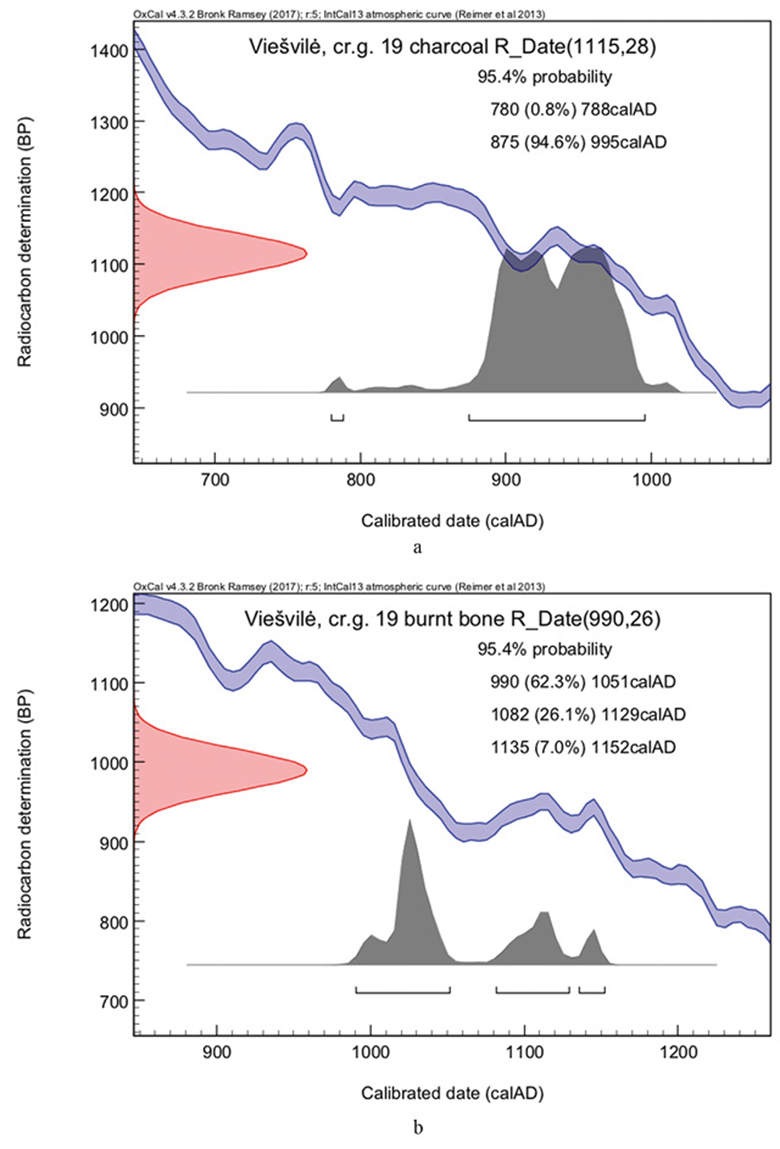
Fig. 4. AMS 14C dates of Viešvilė I grave 19 samples: a. Charcoal; b. Cremated human bone.
4 pav. Viešvilės I kapo Nr. 19 AMS 14C datuoti mėginiai: a. anglis; b. degintinis (kremuotas) žmogaus kaulas
Spatial distribution and typo-chronology of the cremation graves of Viešvilė I cemetery puts most of them within the same proximate timespan of 2–3 generations (Fig. 3). The results of 14C dating of cremated bones and fuel are distributed on a surface of approximately 100 square meters. The regularity and similarity of 14C dating results from different graves on the limited area reflect this situation. The same applies to the textile and wood samples of Viešvilė I, for example from grave 3 (Shiroukhov, 2019, p. 28), the most of which have to be presented in a context of a separate study on the detailed chronology of the cemetery.
Thus, some of the graves of Viešvilė I could be older or younger than others. Considering the difference between the age/date of type and certain artefact. The most of Viešvilė I graves are connected to each other by the artefact types network. For example Petersen E type spearheads, the same as Petersen X, Y, Z types swords and their details were found in 6 from 7 14C-dated graves9 (Budvydas, 2007b, p. 207–212). They are mostly dated to the 10th–beginning of the 11th centuries (Андрощук, 2013, Таб. VI:1; Tomsons, 2018, p. 70–77, Att. 42). The grave 19 with no E type spearheads and swords is connected to grave 1 by 2 types of penannular brooches and weaving tools, the same as with some other artefacts, characteristic mostly of Curonian and Scalvian cultures of the Post-Viking period. It means, that in theory grave 19 could be dated a bit later that the most of the graves with “Viking” types spearheads and swords, but still connected to another sealed deposits of the cemetery. For example, 4 ring-brooches with a ribbed bow of the grave 19, typical mostly for Prussians, Scalvians and South Curonians of the period, are identical to these from grave 16 (Fig. 6). Grave 16 has some other artefacts identical both to grave 19 and other 14C-dated Viešvilė I graves. The most of Viešvilė I artefacts have analogies in other Western Balts cemeteries of the second part of the 10th – first half of the 11th century. Investigator of Viešvilė I U. Budvydas dated the cemetery generally by the 10–11th centuries (Budvydas, 2012, p. 137; 2016, p. 253–255).
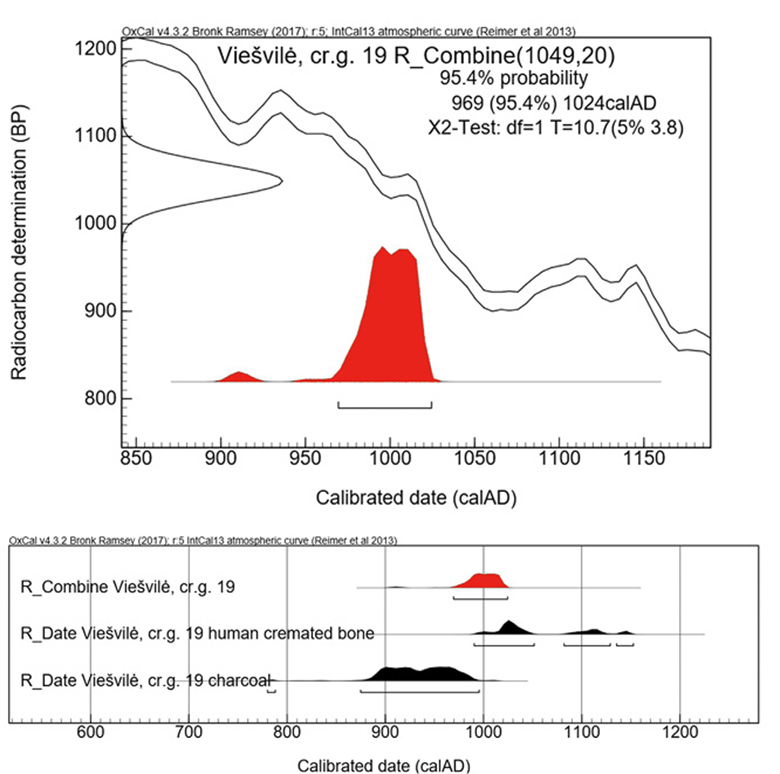
Fig 5. Results of unlikely OxCal combination (red color) of Viešvilė I grave 19 charcoal and human cremated bone samples AMS 14C dates.
5 pav. Spėjamos / netikėtos (raudona spalva) Viešvilės I kapo Nr. 19 medžio anglies ir žmogaus kremuoto kaulo mėginių AMS 14C datų OxCal kombinacijos rezultatai
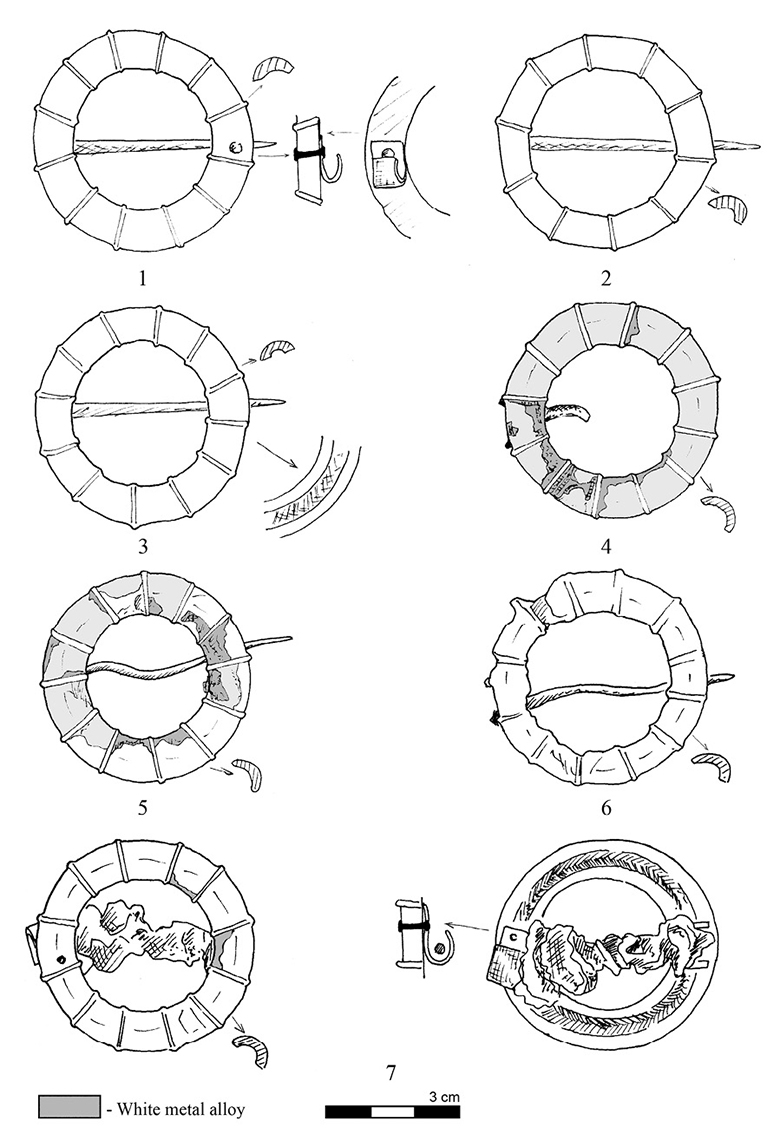
Fig. 6. Ring brooches with a ribbed bow from Viešvilė I cremation graves: 1–3. 16; 4–7. 19 (TIM GEK 32742.1-3, 34687.1-4, drawing by R. Shiroukhov).
6 pav. Viešvilės I degintinių kapų žiedinės segės: 1–3. 16; 4–7. 19 (TIM GEK 32742.1-3, 34687.1-4 (R. Širouchovo piešinys))
Four of Viešvilė I graves10, according to the AMS 14C dates of cremated bones, are related more to the 10th century. Three of the cemetery graves can be attributed more to the second part of the 10th – first third of the 11th century11. Following the radiocarbon curve, grave 3 is dated to 953–1025 AD (about 90% probability), with a 14C curve peak on 980–1020 AD; grave 19, as it was mentioned (cremated bone sample) is dated to 990–1152 AD with a higher probability at 990–1051 AD (62.3%), with a peak of a curve at 1020–1040 AD; grave 22 AMS 14C date is 941–1019 (72.3% probability), with a peak at 980–1000 AD (Tab. 1; Fig. 4, 7). All aforementioned graves are connected by the synchronously dated types of artefacts, as with aforementioned types of arms, the same as by the ornaments, like flat ladder brooches in the case of graves 3 and 22 (Fig. 8). All these conclusions are probabilistic and relate to the reconstruction of possible dates of graves.
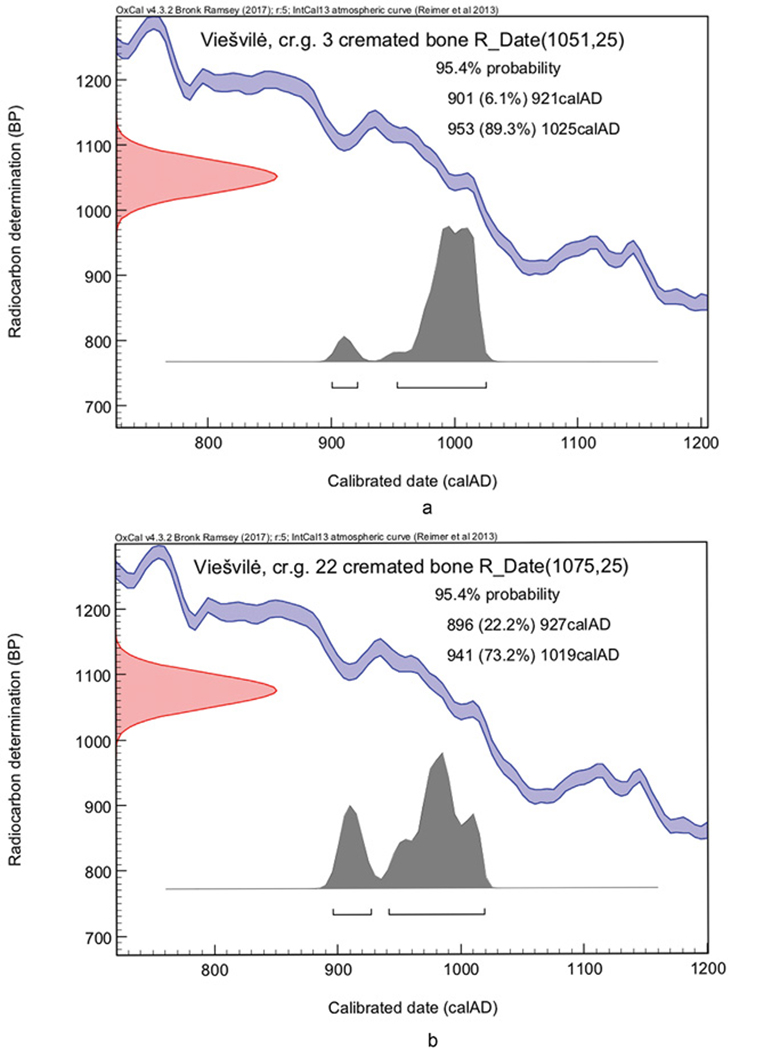
Fig. 7. Results of AMS 14C dating of Viešvilė I graves 3 and 22.
7 pav. Viešvilės I kapų Nr. 3 ir 22 AMS 14C datavimo rezultatai
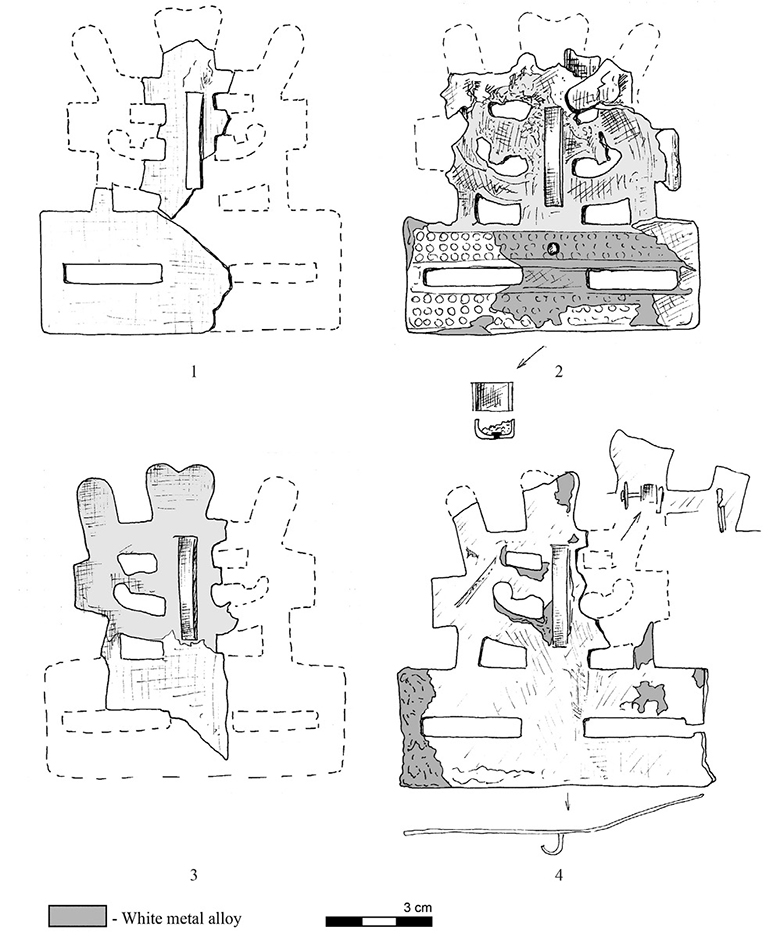
Fig. 8. Flat ladder brooches from Viešvilė I cremation graves: 1. 3; 2–3. 22 (TIM GEK/AP 70/2-80; GEK 32746, 34698.1); 4. Stray find (?) (VDKM 810:73). (Drawing by R. Shiroukhov).
8 pav. Plokštinės laiptelinės segės iš Viešvilės I degintinių kapų: 1. 3; 2–3. 22 (TIM GEK/AP 70/2-80; GEK 32746, 34698.1); 4. Atsitiktinis radinys (?) (VDKM 810:73) (R. Širouchovo piešinys)
It is possible now to simulate the probable distribution of Viešvilė I dates according to the hypothetic phases of the cemetery, constructed on the previous chronological assumptions. Supposing that the investigated part of Viešvilė I belongs to only one phase, where all the graves are directly connected, the results of modelling using the OxCal “phase” sequencing will tie the latest possible dates of 14C-earlier graves 1, 5, 13, 21 to the start of the “later” graves 3, 19 and 22. With the general span of the radiocarbon curve falling between 950–1020 AD (Fig. 9).
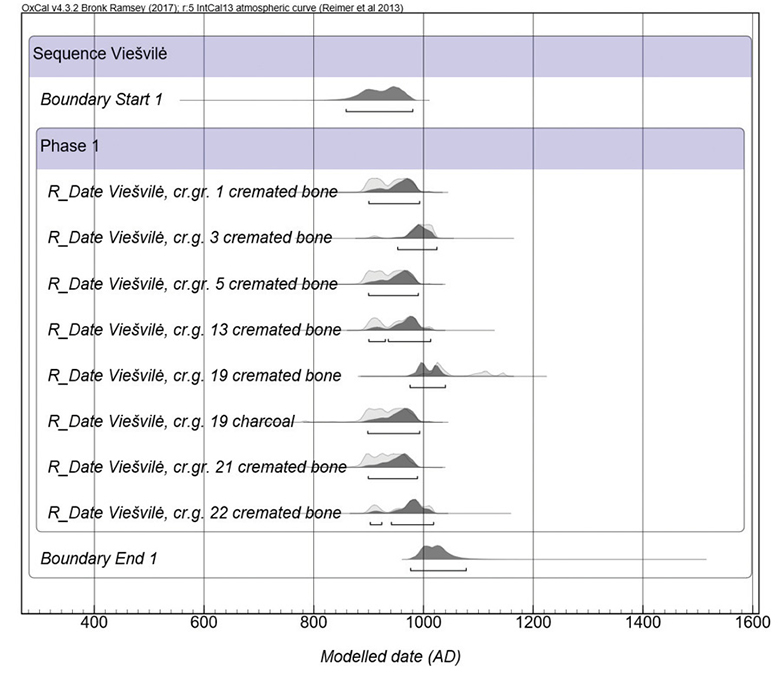
Fig. 9. One phase Viešvilės I AMS 14C dates distribution model.
9 pav. Vienos fazės Viešvilės I AMS 14C datų pasiskirstymo modelis
“1 phase” modelled dates are divided into two visible groups, with concentration of radiocarbon curve at 950–990 AD and 950/970–1030/40 AD. This demonstrates the advantage of using a 2 phases model in the case of the excavated Viešvilė I area, using only cremated bones 14C dates. The result of the application of this model is as follows: according to the basic 14C analysis graves 1, 5, 13 and 21 should be earlier than graves 3, 19 and 22. The first four graves dates are between c. 900–985 AD with a peak of a curve at 950–980 AD, the second group is represented by the dates around 965/980–1020/1040 AD with a peak of a curve at 980–1020/1030 AD (Fig. 10). The situation of 2 phases with the earliest Viešvilė I graves, created around 950–980 AD and the latest, made between 980–1020 AD, correspond to typological dating and clarifies it. The 2 phases model gives the most probable distribution of calendar dates in the case of the investigated part of Viešvilė I.
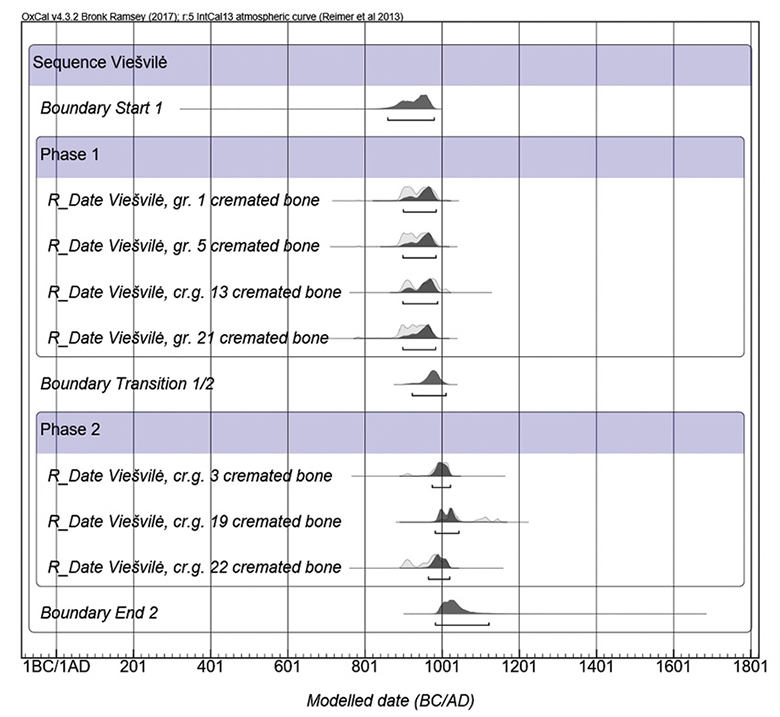
Fig. 10. Two phases Viešvilė I AMS 14C dates distribution model.
10 pav. Dviejų fazių Viešvilės I AMS 14C datų pasiskirstymo modelis
The total number of Viešvilė I AMS 14C-dated samples, including those not presented here of textile and wood, are planned to be analysed in a separate publication together with ArcGIS and R analysis of graves and artefacts statistical features.
Lazdininkai cremation grave 35
Another example of simultaneous dating of cremated bone and a charcoal from the same sealed deposit is given by two samples from Lazdininkai cemetery cremation grave 35, associated with the historical tribe of Curonians. The cemetery today is known more by Roman and Migration Age parts, recently investigated by A. Bliujienė and D. Butkus (Bliujienė, Butkus, 2000, p. 251–254). Grave 35 was found in 1998 together with grave 36 in the area of earlier graves (graves also marked as 35D and 36D). Both graves 35 and 36 were radiocarbon-dated within the auhor’s AvH project, forming a calendar sequence corresponding to typological dating. The results of the AMS 14C dating of a both graves in a context of GIS and statistical analysis with a broad range of typological analogies will be described in a separate study.
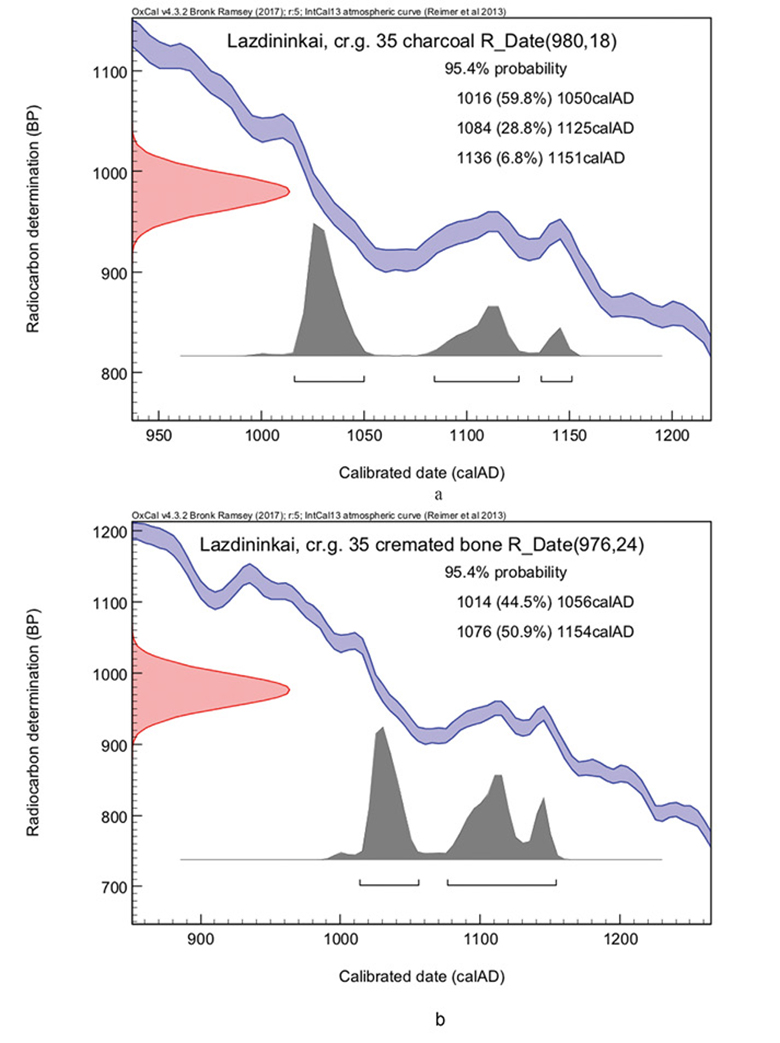
Fig. 11. AMS 14C dates of Lazdininkai cremation grave 35 samples: a. Charcoal; b. Cremated human bone.
11 pav. Lazdininkų degintinio kapo Nr. 35 AMS 14C datuoti mėginiai: a. anglis; b. degintinis (kremuotas) žmogaus kaulas
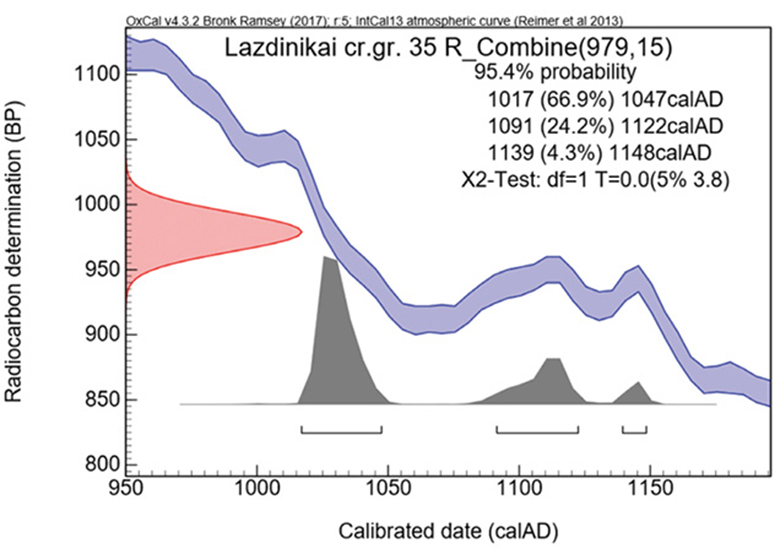
Fig. 12. Results of OxCal combination of Lazdininkai cremation grave 35 charcoal and human cremated bone samples AMS 14C dates.
12 pav. Lazdininkų degintinio kapo Nr. 35 medžio anglies ir žmogaus degintinio kaulo mėginių AMS 14C datų OxCal kombinacijos rezultatai
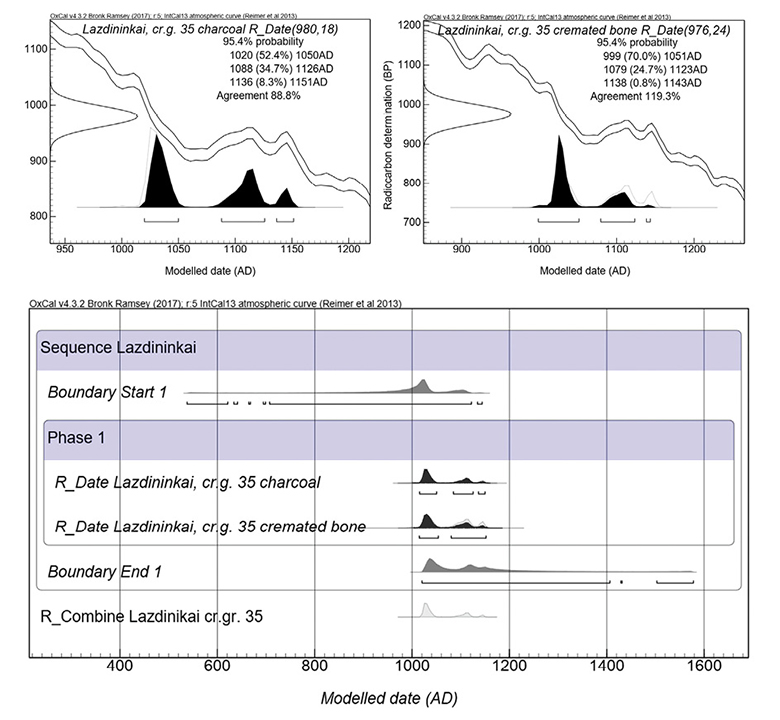
Fig. 13. Application of OxCal „sequence“ function for Lazdininkai cremation grave 35 AMS 14C data.
13 pav. OxCal „sekos“ funkcijos taikymas Lazdininkų degintinio kapo Nr. 35 AMS 14C datavimo duomenims
Due to the ritual (?) conditions of Curonian cremation graves, a small number of graves contained replicate samples of charcoal. Only one charcoal from Lazdininkai gr. 35, occurred within Kretinga History Museum funds (KM), had a visible round wood form. AMS 14C dates of cremated bone and charcoal are similar. 14C AMS date of the cremated bone is 1014–1154 AD (95,4% probability) with two visible peaks of a radiocarbon curve at 1014–1056 AD (44,5%) and 1076–1154 AD (50,9%). Charcoal is dated to 1016–1151 AD (95,4% probability) with a peak of the curve at 1016–1050 AD (59,8% probability) (Fig. 11). Charcoal from grave 35 has a visible diameter of approximately 2 cm. It could belong to a twig with a little chance for the “old wood affect”. Or it could derive from the heartwood of a large fragment of timber. Application of R_Combine function gave the following results: the absolute peak of a curve emphasizes the calendar date of 1017–1047 (66,9% probability) and gives the second chronological “concentration” at 1091–1122 AD (24,2% probability) (Fig. 12). If to apply “Sequence” function, presuming, that the date of a charcoal could be of the more or less same age or a bit earlier then of the cremated bone, the results of AMS 14C dating will be as follows: cremated bone calendar age 999–1051 AD (70% probability) and a charcoal date is 1020–1050 AD (52,4% probability). With the peak of the radiocarbon curve at 1020–1040 AD in both cases (Fig. 13). Judging by the aforementioned calculations the most appropriate calendar age of a Lazdininkai cremation grave have to be the first third-half of the 11th century. Though the 20–30% probability of another date – last third of a the 11 – first half of the 12th centuries have to be not ignored. Both samples of presumably-detected young age charcoal and cremated bone give very close dates because they could both date the moment of cremation with little chance of external contamination. What about Lazdininkai 35 grave typological chronology? Authors of excavations date the grave rather accurately by the 10–12th centuries (Bliujienė, Butkus, 2000, p. 254). Grave 35 is richly furnished, being represented by 23 artefacts: penannular brooches of several types (including one with star-shaped terminals), bracelets, spiral necklaces fragments, battle narrow blade axe, socked spearhead and bridle bits (Bliujienė, 1999, p. 28, 46–47; Bliujienė, Butkus, 2000, p. 254–255). All finds can be dated from the first third of the 11th to the very beginning of the 12th century, corresponding to the AMS 14C date. But there are no artefacts specific only, for example to the Late Viking age of Viešvilė I graves of the second part of the 10th – very beginning of the 11th century, or artefacts specific to the 12th century, as some brooches from Palanga described below. That means the most possible typological date of the Lazdininkai 35 grave is the 11th century. The AMS 14C date specifies relative dating to the first half of the 11th century. If to mention in addition the elongated form of Lazdininkai grave 35 pit, it should be stated, that the last one is closer to the Curonian inhumation graves of the 10th – beginning of the 11th century, than to later cremations. The penannular brooch with starshaped terminals type, found in Lazdininkai grave 35 have rather a long chronology, from the first third of the 11th to the beginning of the 13th century, making connection to some of another Lazdininkai and Palanga graves mentioned below (Fig. 14, 18, 19).
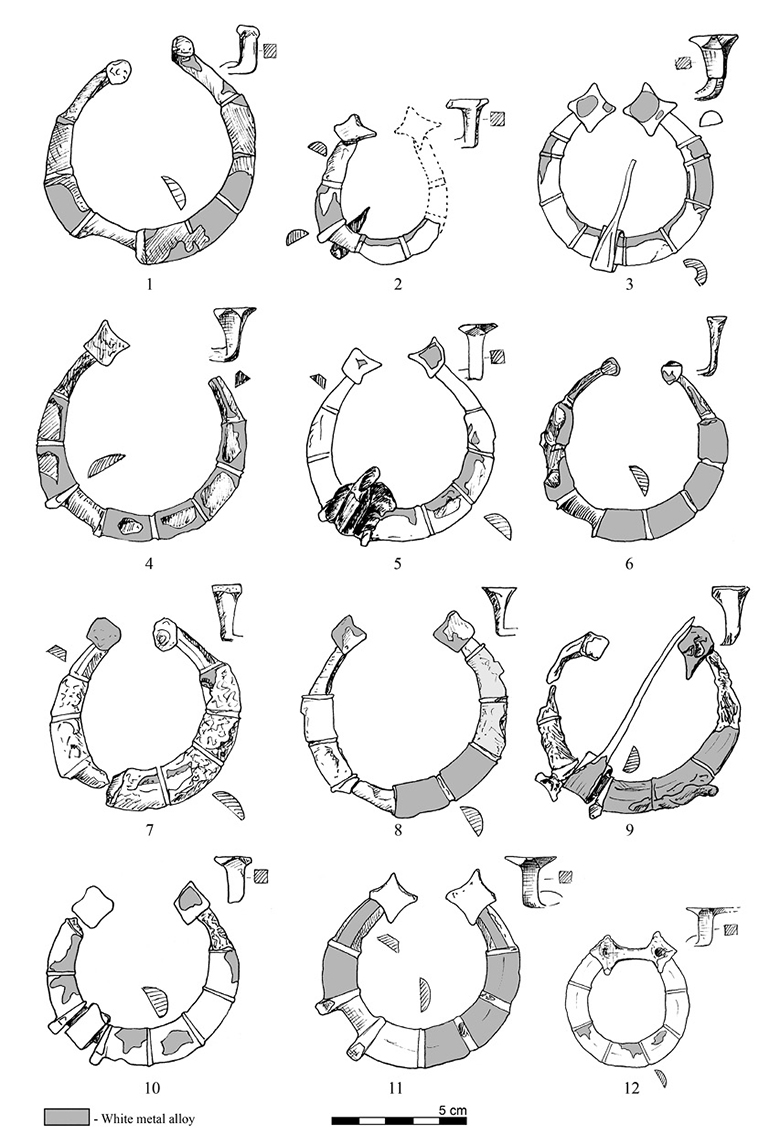
Fig. 14. Penannular brooches with star-shaped terminals from Lazdininkai cremation graves: 1–2. 35; 3. 45; 4. 94; 5. 100; 6. 115; 7. 124; 8. 167; 9. 172; 10. 180; 11–12. Stray find (?) (1–10: KM LS 2061:81, 2061:29; KM 327, 856, 948, 1149, 1238, 1618, 1673, 1790; 11–12. VDKM 1774:10, 1774:52, drawing by Roman Shiroukhov).
14 pav. Pasaginės segės žvaigždiniais galais iš Lazdininkų kapinyno degintinių kapų: 1–2. 35; 3. 45; 4. 94; 5. 100; 6. 115; 7. 124; 8. 167; 9. 172; 10. 180; 11–12. Atsitiktinis radinys (?) (1–10: KM LS 2061:81, 2061:29; KM 327, 856, 948, 1149, 1238, 1618, 1673, 1790; 11–12. VDKM 1774:10, 1774:52) (R. Širouchovo piešinys)
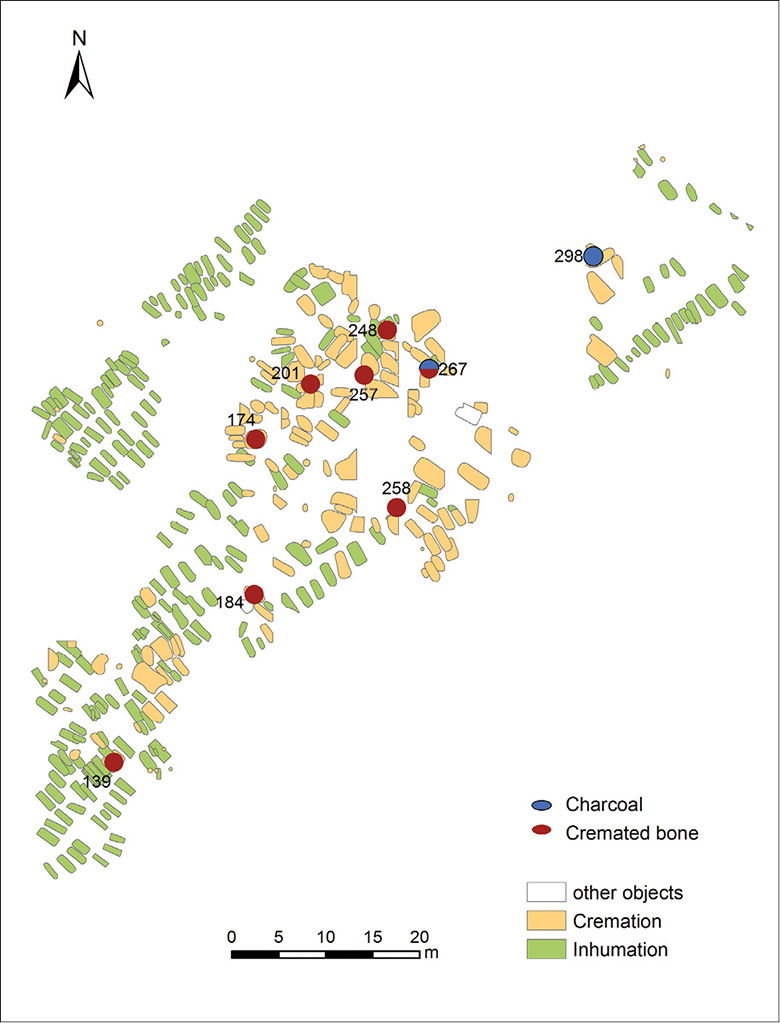
Fig. 15. Spatial distribution of Palanga radiocarbon-dated samples of cremated bones and charcoal (drawing by R. Shiroukhov and K. Göbel after Grikpėdis, 2012, Pl. 2).
15 pav. Palangos kapinyno degintinių kaulų ir medžio anglies radioanglies datuotų mėginių erdvinis pasiskirstymas (R. Širouchovo ir K. Göbelio piešinys pagal Grikpėdis, 2012, pl. 2)
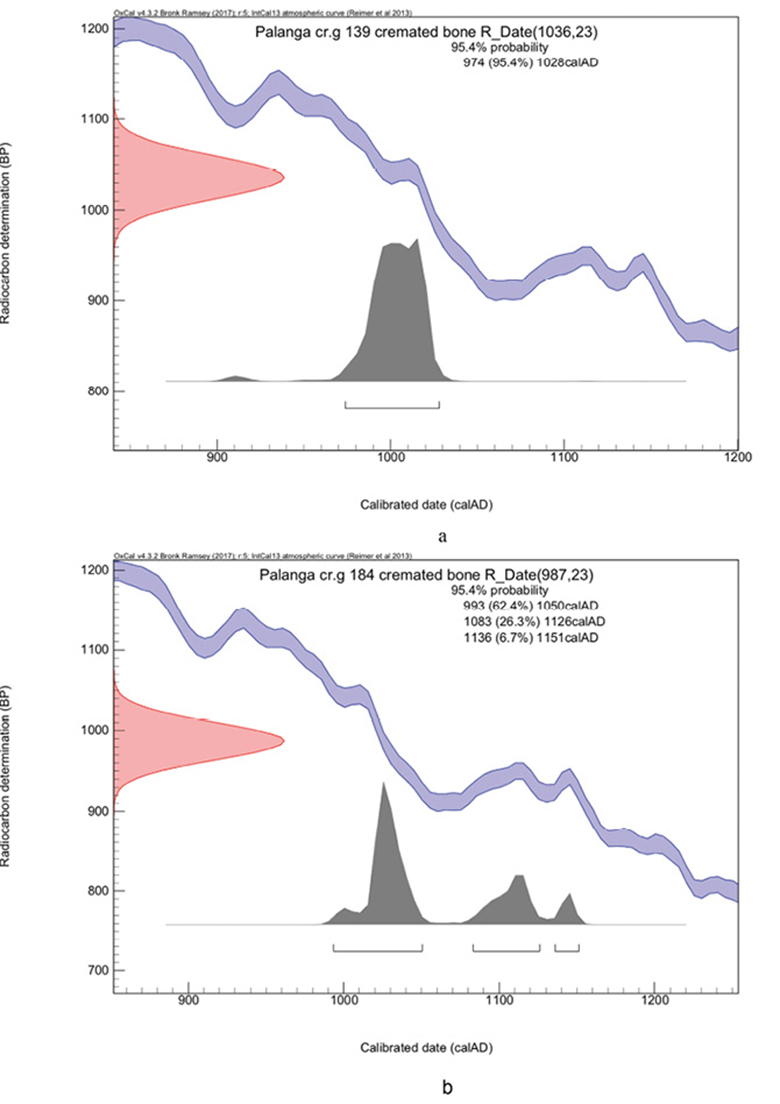
Fig. 16. AMS 14C dates of Palanga graves 139 and 184.
16 pav. Palangos kapinyno kapų Nr. 139 ir 184 AMS 14C datos
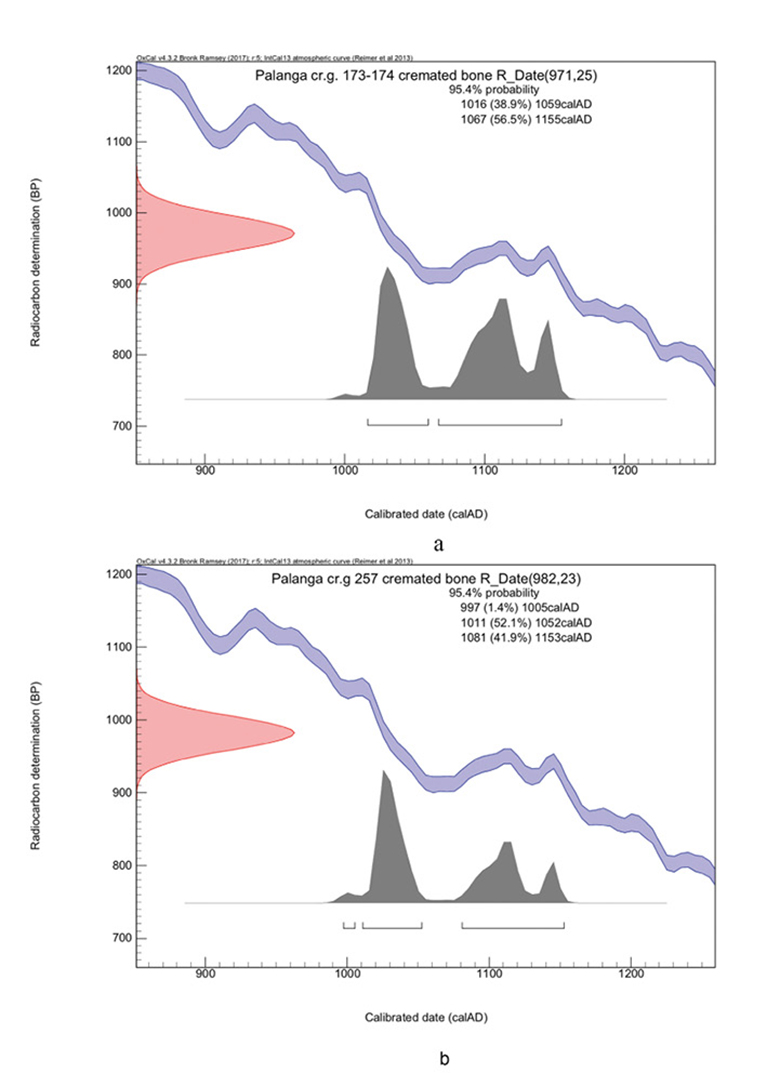
Fig. 17. AMS 14C dates of Palanga graves 174 and 257.
17 pav. Palangos kapinyno kapų Nr. 174 ir 257 AMS 14C datos
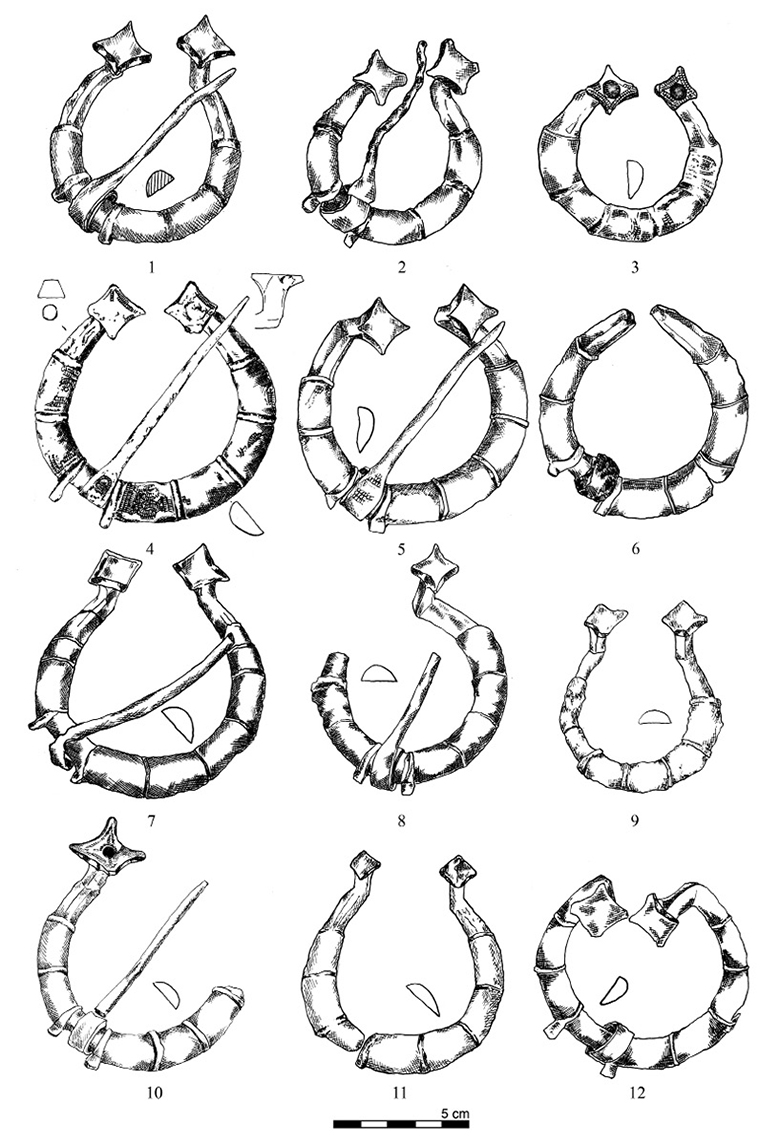
Fig. 18. Penannular brooches with star-shaped terminals from Palanga cremation graves (1–6, 8–11): 1. 134; 2. 171; 3. 174; 4. 175; 5. 203; 6. 210; 7. 227 (inhumation grave); 8. 252; 9. 258; 10. 279; 11. 303a; 12. Excavation Area XV (LNM AR 396: 1062, 1418, 1442, 1465, 1690, 1739, 1826, 1977, 2048, 2184, 2291, 2933). Drawing by A. Ruzienė/LNM AK, composed by R. Shiroukhov.
18 pav. Pasaginės segės žvaigždiniais galais iš Palangos kapinyno degintinių kapų: (1–6, 8–11): 1. 134; 2. 171; 3. 174; 4. 175; 5. 203; 6. 210; 7. 227 (griautinis kapas); 8. 252; 9. 258; 10. 279; 11. 303a; 12. Plotas Nr. XV (LNM AR 396: 1062, 1418, 1442, 1465, 1690, 1739, 1826, 1977, 2048, 2184, 2291, 2933). A. Ruzienės (LNM AK) ir R. Širouchovo piešinys
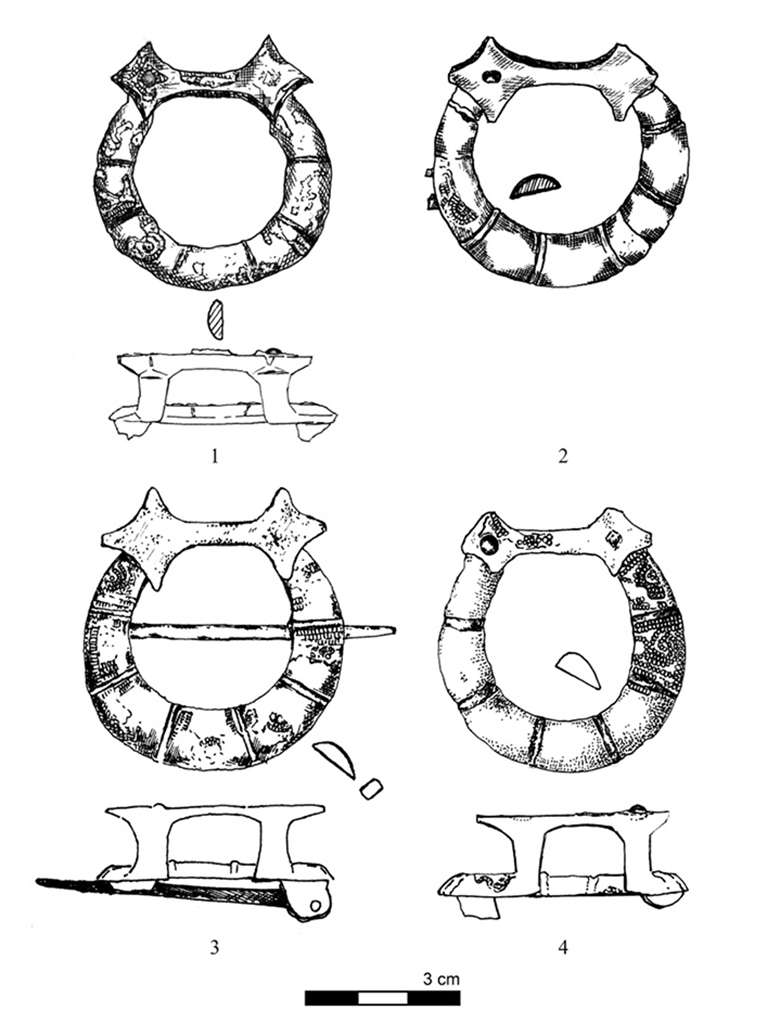
Fig. 19. Penannular brooches with connected star-shaped terminals from Palanga cremation graves: 1. 138; 2. 167; 3. 198; 4. 201 (LNM AR 369: 1090, 1393, 1624, 1667). Drawing by A. Ruzienė/LNM AK, composed by R. Shiroukhov.
19 pav. Pasaginės segės sujungtais žvaigždiniais galais iš Palangos kapinyno degintinių kapų: 1. 138; 2. 167; 3. 198; 4. 201 (LNM AR 369: 1090, 1393, 1624, 1667). A. Ruzienės (LNM AK) ir R. Širouchovo piešinys
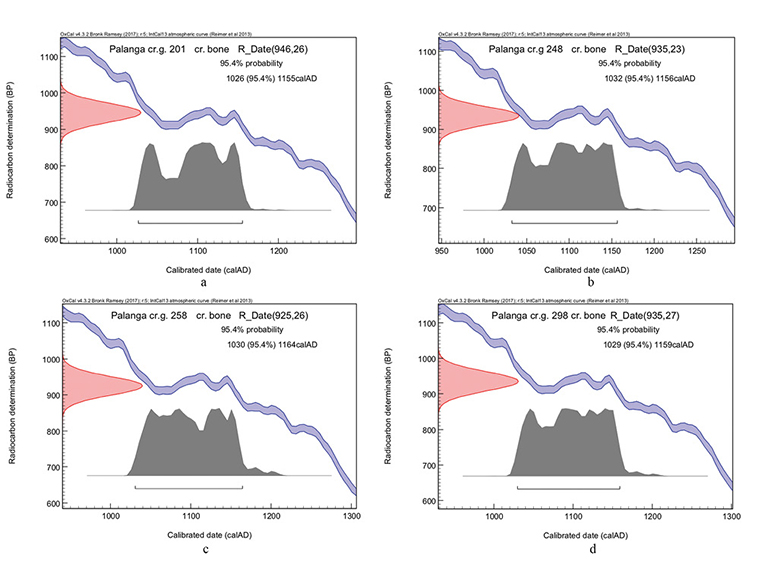
Fig. 20. AMS 14C dates of Palanga graves 201, 248, 258 and 298.
20 pav. Palangos kapinyno kapų Nr. 201, 248, 258 ir 298 AMS 14C datos
Palanga cremation graves
The last series of AMS 14C dates of the study are represented by 10 samples from 9 Palanga cremation graves, the same as Lazdininkai, associated with the southern branch of Curonian, or West Lithuanian (Klaipėda-Niemen/Memel) archaeological culture. According to the 1961–1962 archaeological reports of A. Tautavičius 373 graves were excavated at Palanga cemetery: 136 cremations and 237 inhumations (Tautavičius, 1961; 1962a; 1962b; 1963; Mockus, 2011, p. 32).
Looking at the plan of the Palanga excavations it is evident, that most of the 14C dated graves are accumulated in the northern part of the cemetery, one cremation (298) is located 20 m. to the N-O from this group and two of them (139, 184) are located in the southern part of the cemetery in between supposedly earlier inhumation graves, usually dated to the 8/9–10/11th centuries (Fig. 15). How does the plan of the cemetery reflect the chronological situation?
The form and size of the Palanga grave 139 (2.1 × 0.4–0.6 m.) and some of its features, like a spearhead in the north part of a grave, connect it to the earlier inhumation graves of the cemetery (Tautavičius, 1961, p. 163–164). Grave 139 located in a bigger pit together with cremation graves 136–139 erected in coffins within the concentration of inhumation graves. The author of excavations A. Tautavičius mentioned that cremation graves 137–139 could be dated a little bit later than the inhumations surrounding them, because of such finds as penannular brooches (with connected star-shaped terminals, gr. 138) (Tautavičius, 1961, p. 164). Judging from the stratigraphic situation, graves 137 and 138 could be directly chronologically connected to the grave 139 radiocarbon date. The same, with some exceptions, can be stated for Palanga grave 184.
AMS 14C date of the grave 139 is the earliest and the most “compact” (due to the features of radiocarbon curve) from the list, giving the calibrated date of 974–1028 AD (95.4% probability), with the peak of the curve at 990–1020 AD. Grave 184, located in between grave 139 and the main concentration of cremation graves, thus is dated by the wider span of 993–1151 AD (95,4%) with an emphasis on 993–1050 AD (62.4%), and the peak of the curve at 1020–1040 AD (Fig. 16). The third date belongs to grave 257, located within the southern concentration of cremation graves. The AMS 14C date of the grave 257 is rather broad: 997–1153 AD (95.4%) with two possible peaks of radiocarbon curve at 1011–1052 (52,1%) and, 1081–1153 (41.9%). Grave’s 257 14C curve is a bit similar to the one of the grave 17412, 1016–1155 AD (95.4%) with two peaks on 1016–1059 AD (38.9%) and 1067–1155 AD (56.5%) (Fig. 17). Both graves 174 and 257, located at a distance of about 10 m. from each other, are additionally connected by the penannular brooches with star-shaped terminals, found in a both of them. Such brooches were also found in 14C-dated grave 258 and, if to mention these with connected star-shaped terminals, in graves 201 and 267 (Fig. 18, 19). The same can be said about flat ladder brooches, found in graves 248 and 298. They are similar to these found at Viešvilė I, but represent later subtypes.
The results of AMS 14C dating of the other 5 graves are almost identical: between 1025–1164 AD (95.4 %). Most of the Palanga 14C-dated graves, as mentioned above, form a compact spatial and chronological network, starting not earlier than year 1000 AD and developing until c.1160 AD (Fig. 20). Is it possible to clarify these dates, or, at least, to model them? If to suppose, that graves 139 and 184, territorially “isolated” from the general group of cremations, form one chronological group, and northern 6 graves – another, it is possible to apply Phases sequencing in OxCal. Palanga cemetery represent two visible 2 phases. Phase 1 with graves 139 and 184 give dates of 980–1020 AD (95.4%) and 990–1050 AD (84.7%) accordingly. These 2 dates are concentrated around year 1000 AD, with the peak of the curve at 1020–1040 AD. This estimated phase generally coincide with a typological dating of these two graves. Marking both the end of the existing of Viešvilė I latest cremation graves, and corresponding to Lazdininkai grave 35. Phase 2 of Palanga gives sequence of 7 dates, marking the timespan after 1020 and before the year around 1150 AD (95,4%), with a highest possibility at 1070–1150 AD (about 80% probability), and a peak of a curve at 1090–1120 (Fig. 21). It is important to recall that all these calculations are scientific approximation.
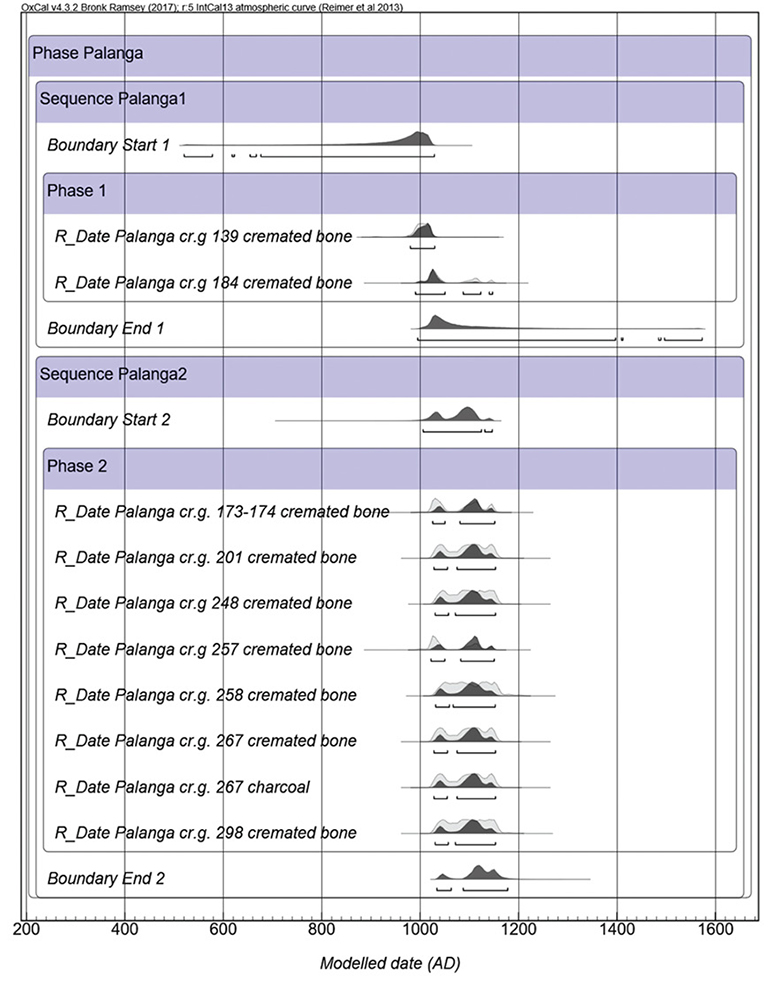
Fig. 21. Two phases Palanga AMS 14C dates distribution OxCal model.
21 pav. Dviejų fazių Palangos AMS 14C datų paskirstymo modelis
GIS plan of the cemetery reveals how the cremation graves shift from the south to the north, forming the biggest concentration. According to this geospatial view, grave 139 must be dated earlier than grave 298. This could be confirmed by the typological dating of the north located 14C-dated cremations of Palanga 248 and 298, both having the flat ladder brooches of the R. Spirgis B type, dated usually by the second part of the 11 – beginning of the 12th centuries (Spirgis, 2002) (Fig. 22).
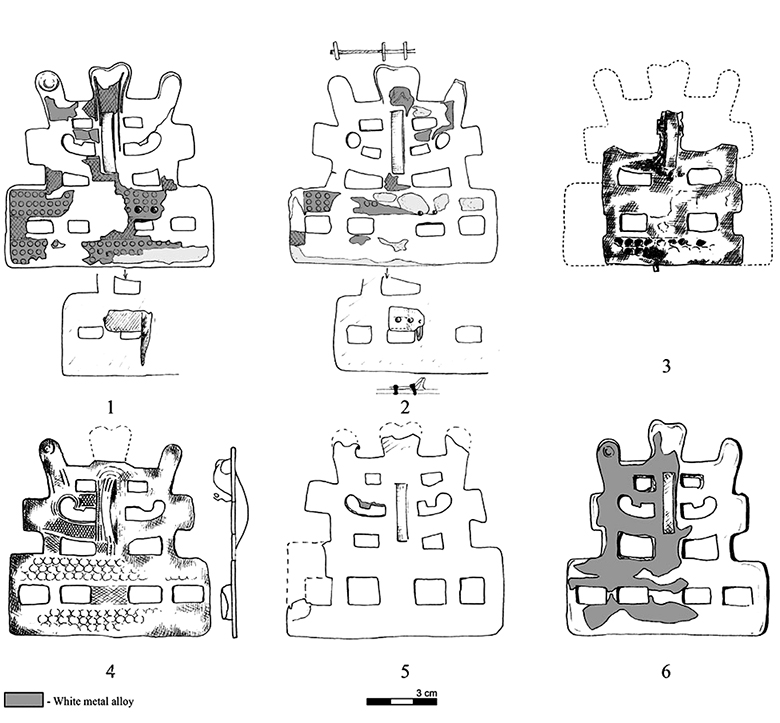
Fig. 22. Flat ladder brooches from Palanga (1–5) and Lazdininkai (6) cremation graves: 1. 231; 2. 274 (inhumation); 3. 248; 4. 298; 5. Excavation area VI; 6. 179 (1–5. LNM AR 396: 1884, 2173, 1951, 2268, 2647; 6. KM17548. Drawn and composed by R. Shiroukhov (1–3, 5–6) and A. Ruzienė (3–4).
22 pav. Plokštinės laiptelinės segės iš Palangos (1–5) ir Lazdininkų (6) degintinių kapų: 1. 231; 2. 274 (griautinis kapas); 3. 248; 4. 298; 5. Plotas Nr. VI; 6. 179 (1–5. LNM AR 396: 1884, 2173, 1951, 2268, 2647; 6. KM17548. R. Širouchovo (1–3, 5–6) ir A. Ruzienės (3–4) piešinys
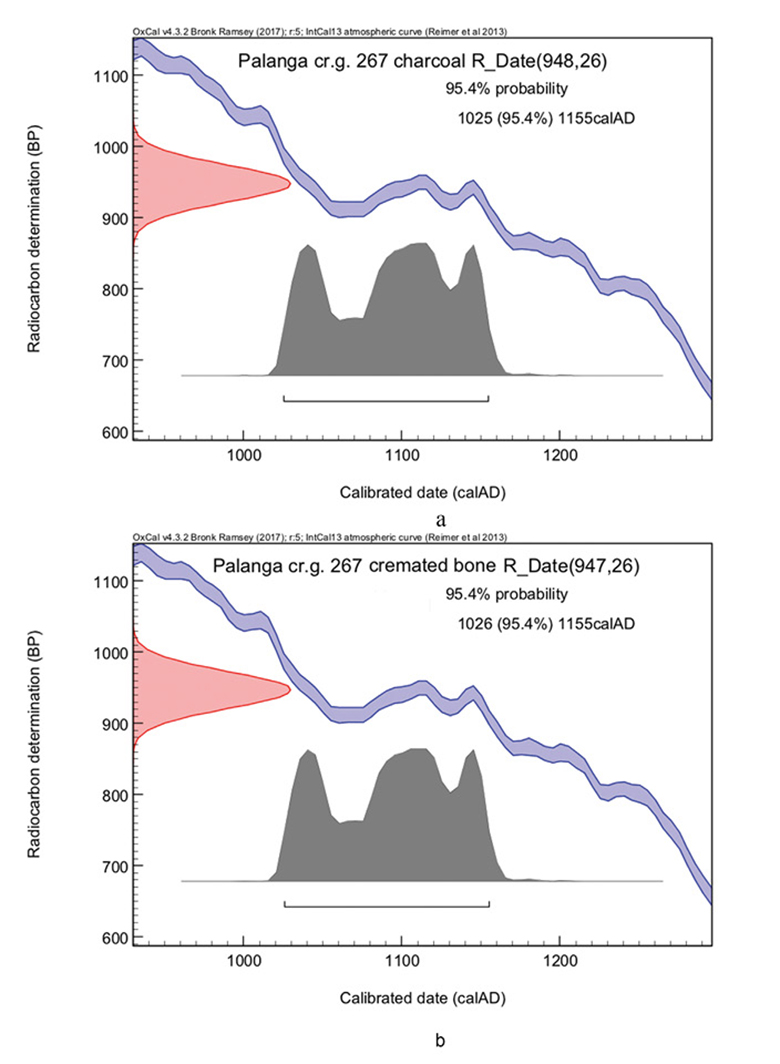
Fig. 23. AMS 14C dates of Palanga cremation grave 267 samples: a. Charcoal; b. Cremated human bone.
23 pav. Palangos degintinio kapo Nr. 267 AMS 14C datuoti mėginiai: a. anglis; b. degintinis (kremuotas) žmogaus kaulas
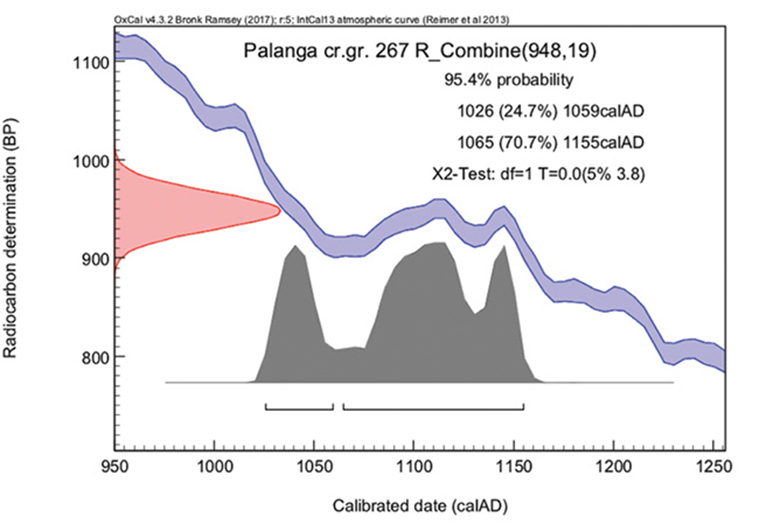
Fig. 24. Results of OxCal combination of Palanga grave 267 charcoal and human cremated bone samples AMS 14C dates.
24 pav. Palangos degintinio kapo Nr. 267 medžio anglies ir žmogaus degintinio kaulo mėginių AMS 14C datų OxCal kombinacijos rezultatai
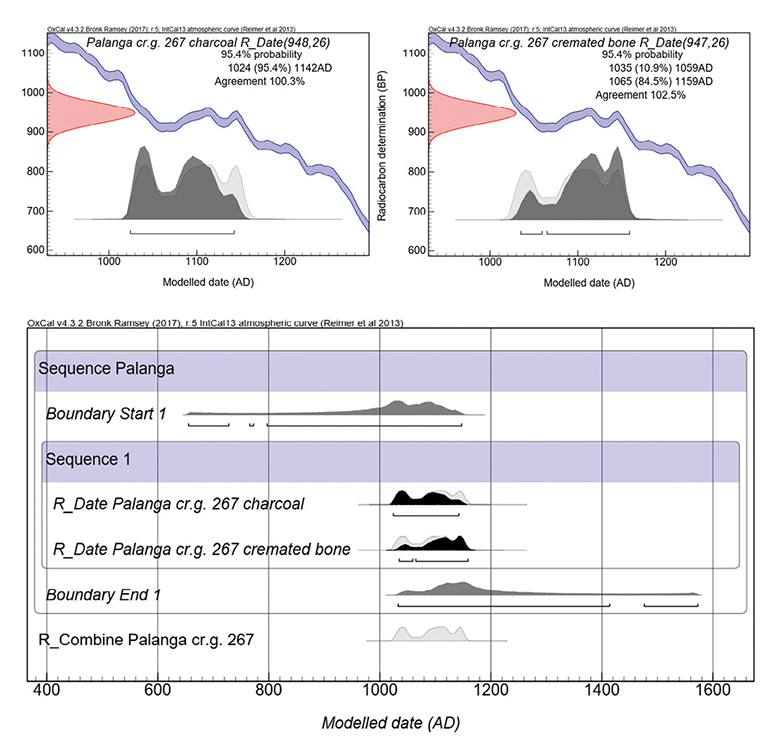
Fig. 25. Results of application of OxCal “sequence” function for Palanga grave 267 charcoal and human cremated bone samples AMS 14C dates.
25 pav. OxCal „sekos“ funkcijos taikymas Palangos degintinio kapo Nr. 267 AMS 14C datavimo duomenims
Going back to the simultaneous dating of cremation bones and fuel, let me consider again two AMS 14C dates of cremated bone and a piece of charcoal from Palanga 267. Both dates are almost identical. AMS 14C date of charcoal is 1026–1156 AD (95.4%) and the same one of cremated bone is 1025–1155 AD (95.4%) (Fig. 23). The charcoal fragment was too small to determine the initial age of the wood. Judging by the previous suggestions of the limited and probabilistic impact of the old wood effect on the date of cremated bone, simultaneously of grave 267’s radiocarbon curve to other Palanga cremations of the northern group of graves, it is possible to state the reliability of two dates. Both dates confirm the synchronous dating of the span of the cremation process, absorbing a new carbon from a pyre. The combination of them gives a broad range of 1025–1155 AD (95.4%) with a lesser possibility of date at 1026–1059 AD (24.7%) and a stress at 1065–1155 (70.7%) (Fig. 24). Almost the same results can be obtained applying OxCal-sequencing of grave 267 14C dates. If to suppose, that the charcoal hypothetically could belong to an older wood, and the cremated bone sample is dating the moment of cremation more precisely, the results will be as follows: the broad 14C date of charcoal is still around 1024–1142 AD (95.4%), the broad date of cremated bone is 1035–1159 with an emphasis at 1065–1159 (84.5%) (Fig. 25). Grave 267 of Palanga has only few datable artefacts. Penannular brooch with star-shaped connected terminals gives it a date “terminus post quem” of the first quarter of 11th century. Grave 267 is linked to grave 201 with the same type of brooch and other datable sets of artefacts, such as the Petersen M-type battle-axe and several penannular broches. Beside the penannular broches, which can be dated from the first half of the 11th till the beginning of the 12th century, the battle axe is corresponding to Atgazis M2 subtype which also can be dated by the 11th – beginning of the 12th centuries (Atgazis, 2019, p. 128). So, in theory both graves 267 and 201 could be dated by the first time-span of 1020–1060 AD, but the date after 1050 and before 1150 is preffered, judging by the typological chronology and OxCal modelling. The author’s personal experience working with data and 14C dates of such Curonian cemeteries as Bandužiai, Ramutten, Ranku Kapenieki etc. also suggests the preference for the most of 14C dated Palanga cremation graves to be from the second part of the 11th – beginning of the 12th centuries. The reliability of the Palanga 14C and typological dates has to be checked after through the ArcGIS spatial and statistical analysis.
The cremation graves of Palanga have no visible typological features of the Late Viking Age cremation graves of Viešvilė I. Because the most of them start when the most of Viešvilė I graves end with a possible span of several decades.
Summing up the application of OxCal Phase function to Viešvilė I and Palanga cemeteries, it is possible to connect these cemeteries to each other and with Lazdininkai grave 35. To reiterate, phase 1 around 950–980 AD is represented by Viešvilė I graves 1, 5, 13 and 21; phase 2 of approximately 980–1020 AD is reflected by Viešvilė I graves 3, 19 and 22 and possibly by Palanga grave 139. Phase 3 of presumable 1020–1050 AD is associated with Lazdininkai grave 35 and probably with Palanga grave 184. Other graves of the Palanga cemetery belong to the phase 4, dated between 1070–1150 AD with a peak at 1090–1120 AD. All aforementioned phases are statistical estimation, based on AMS 14C analysis data-sets.
The detailed research of every dated cemetery mentioned above, using the spatial GIS and statistical (seriation and CA) chronological modelling is planned to be published in the future. The same applies to the Prussian cremation cemeteries AMS 14C data gained through out implementation of the AvH project.
Conclusions
First results of the AMS 14C dating of the cremated bones and charcoal samples of the Western Balts cemeteries demonstrate, that the use of the technique is justified. Radiocarbon dating of the bioapatite of cremated bone provides a reliable chronological method for the Late Iron Age of the East Baltic region. Further case studies and more methodological research are needed, but the technique has the potential to help develop a systematic and independent chronological framework to access dramatic social changes that characterised the Iron Age (Fitzpatrick, 2017, p. 377).
The correspondence of the AMS 14C dating results to the preliminary typological dates (and even their clarification) shows the reliability of AMS 14C dating of cremated bones and charcoal fragments from cremation cemeteries sealed deposits (graves) for the historical period. This provides an opportunity for evaluation and the verification of the AMS 14C dating method itself. It is hoped that interest in this study will create additional opportunities to replicate some of KIA-dated samples in other AMS laboratories, in order to provide cross-laboratory checks.
During the AMS 14C dating of paired samples of charcoal and cremated human bone, it appeared, that in the case of Lazdininkai gr. 35 and Palanga gr. 267 radiocarbon/calendar dates are almost identical, but in case of Viešvilė I gr. 19 the date of charcoal is earlier than of burnt bone. If the age difference between corpse and fuel is minimal, a 14C date of calcined bone will reflect the former’s true age. In the great majority of cases, this is reliable, since the fuel for the pyre would be dead branch wood and small felled trees. In other words, 14C dates of cremated bone in most circumstances should be a true reflection, even if indirectly, of the sample’s age. 14C dates of cremated/calcined bone are likely to be closer to the bone’s true age since these still contain endogenous apatite carbon13 and/or have taken carbon mainly from the body itself (collagen) (Snoeck et al., 2014, p. 600). Thus, the dating of cremation bones is a priority. From another point, two cases of synchronous dating of cremated bone and charcoal, demonstarte that in most of the simultaneous cases the differences in dates are not significant14.
The next step of the study, altogether with aforementioned ArcGIS and statistical analysis of the cemeteries data, could be the implementation of Bayesian modelling with the aim of producing the most reliable statistical estimates of the dates of events, such as of construction of cremation graves (Garrow et al., 2014, p. 220). Using the systematic and innovative approach of applicable publications on both radiocarbon dating and Baeysian modeling of funerary monuments with closed complexes (Bronk Ramsey, 2009b; Bayliss et al., 2013; Garrow et al., 2014).
Acknowledgements
First of all, I would like to thank Ugnius Budvydas, [Donatas Butkus], Audronė Bliujienė and National Museum of Lithuania Archaeological department team (Eglė Griciuvienė, Gediminas Petrauskas and Aušra Smaižytė) to make it possible to work with artefacts and organic remains from the Viešvilė I, Lazdininkai and Palanga cemeteries. The same goes to Justina Kozakaitė who helped me to sample the skeletal remains of Viešvilė I cemetery stored at the Vilnius University Medicine Faculty. I’m grateful to Christian Hamann and John Meadows from Leibniz Laboratory for Radiometric Dating and Stable Isotope Research for their help and patience in explaining to me the enigma of AMS radiocarbon dating in detail. I also want to thank Aleks Pluskowski for a discussion on the manuscript of the article. And finally, I’m thankful to Alexander von Humboldt Foundation and personally to Claus von Carnap-Bornheim for the opportunity to support this research.
Abbreviations
FTMC – Vilnius Radiocarbon Laboratory of the Center for Physical Studies and Technology
GIN – Laboratory of the Geological Institute of Russian Academy of Sciences
Ki – Kiev Radiocarbon Laboratory of Institute of Environmental Geochemistry of National Academy of Sciences and
Ministry of Extraordinary Situation of Ukraine
KIA – Leibniz Laboratory for Radiometric Dating and Stable Isotope Research of the Christian-Albrechts-University
of Kiel
KM – Kretinga Museum
LNM – Lithuanian National Museum, Vilnius
Poz – Poznań Radiocarbon Laboratory
TIM – Trakai History Museum
VDKM – The Vytautas the Great War Museum, Kaunas.
Vs – Laboratory of Nuclear Geophysics and Radioecology of the Nature Research Centre, Vilnius
Manuscripts
Bliujienė A. 1999. Lazdininkų (Kalnalaukio) kapinyno (Kretingos raj.) 1998 metų archeologinių tyrinėjimų ataskaita (tekstas, piešiniai). Kultūros paveldo centro paveldosaugos biblioteka, f. 39, ap. 1, b. 304.
Mockus M. 2011. Pietinių kuršių IX–XIII a. pirmosios pusės visuomenės socialinė struktūra kapinynų duomenimis (vad. doc. dr. Audronė Bliujienė). Magistro baigiamasis darbas. Klaipėda.
Tautavičius A. 1961. 1961 m. balandžio mėnesio 12–29 d. d. vykdytų archeologinių kasinėjimų Palangoje, Dariaus ir Girėno gatvėje ataskaita. Lietuvos istorijos instituto rankraštynas, f. 1, b. 111.
Tautavičius A. 1962a. Palangoje, Komjaunimo gatvėje esančio senkapio, tyrinėjimų ataskaita. II dalis (už tyrinėjimus vykdytus nuo 1961 m. rugsėjo 22 d. iki spalio 14 d.). Vilnius, 1961. Lietuvos istorijos instituto rankraštynas, f. 1, b. 112.
Tautavičius A. 1962b. Palangoje, Komjaunimo gatvėje esančio senkapio archeologinių kasinėjimų, vykdytų 1962 m. balandžio 23 – birželio 13 d., ataskaita. Vilnius, 1962. Lietuvos istorijos instituto rankraštynas, f. 1, b. 183.
Tautavičius A. 1963. Palangos senkapio 1962 m. rugsėjo 14 – spalio 17 d. vykdytų kasinėjimų ataskaita. Vilnius, 1963. Lietuvos istorijos instituto rankraštynas, f. 1, b. 182.
Literature
Agerskov Rose H., Meadows J., Palstra S., Hamann C., Boudin M., & Huels M. (n.d.). Radiocarbon Dating Cremated Bone: A Case Study Comparing Laboratory Methods. Radiocarbon, 1–11. DOI: https://doi.org/10.1017/RDC.2019.70 Published online by Cambridge University Press: 28 June 2019.
Atgazis M. 2019. Tuvcīņas ieroči Latvijā 10.–13.gadsimtā. Latvijas vēstures institūta apgāds. Riga.
Bayliss A., Hines J., Høilund Nielsen K., McCormac F. G., Scull C. 2013. Anglo-Saxon Graves and Grave Goods of the 6th and 7th Centuries AD: A Chronological Framework. Society for Medieval Archaeology. Monograph 33. London: Maney.
Bliujienė A., Bračiulienė R. 2018. Užpelkių kapinynas Lietuvos pajūrio ir Baltijos jūros regiono kultūriniuose kontekstuose. Vilnius: Vilniaus dailės akademijos leidykla.
Bliujienė A., Butkus D. 2000. Lazdininkų (Kalnalaukio) kapinyno tyrinėjimai 1998 m. Archeologiniai tyrinėjimai Lietuvoje 1998 ir 1999 metais, p. 252–255.
Bliujienė A., Stančikaitė M., Piličiauskienė G., Mažeika J., Butkus D. 2017. Human-horse burials in Lithuania in the late second to seventh century AD: A multidisciplinary approach. European Journal of Archaeology, 20 (4), p. 682–709. https://doi.org/10.1017/eaa.2017.14
Bronk Ramsey C. 2009a. Dealing with outliers and offsets in radiocarbon dating. Radiocarbon, 51 (3), p. 1023–1045. https://doi.org/10.1017/s0033822200034093
Bronk Ramsey C. 2009b. Bayesian analysis of radiocarbon dates. Radiocarbon, 51 (1), 337–360. https://doi.org/10.1017/s0033822200033865
Budvydas U. 2002. Viešvilės kapinynas. Archeologiniai tyrinėjimai Lietuvoje 2001 m., p. 118–119.
Budvydas U. 2005. Viešvilės kapinynas. Archeologiniai tyrinėjimai Lietuvoje 2003 m., p. 114–118.
Budvydas U. 2007a. Viešvilės kapinynas bei neįtvirtinta gyvenvietė. Archeologiniai tyrinėjimai Lietuvoje 2005 m., p. 110–113.
Budvydas U. 2007b. About some aspects of Scalvian armament on the basis of investigations in Viešvilė cemetery. Archaeologia Baltica, vol. 8. Weapons, Weaponry and Man: In Memoriam Vytautas Kazakevičius (ed. A. Bliujienė), p. 205–213.
Budvydas U. 2012. Viešvilė cemetery I:, Archaeological Investigations in Independent Lithuania 1990–2010. G. Zabiela, Z. Baubonis and E. Marcinkevičiūtė (eds.). Vilnius, p. 132–137.
Budvydas U. 2016. Peculiarities of Scalvian Funeral Rites: A Hundered Years of Archaeological Discoveries in Lithuania. G. Zabiela, Z. Baubonis and E. Marcinkevičiūtė (eds.). Vilnius, p. 248–255.
Fitzpatrick A. P., Hamilton D., Haselgrove C. 2017. Radiocarbon dating and Bayesian modelling of the Late Iron Age cremation burial cemetery at Westhampnett (West Sussex/GB). Archäologisches Korrespondenzblatt, Jahrgang, 47, Heft 3, p. 359–381.
Garrow D., Meadows J., Evans Ch., Tabor J. 2014. Dating the Dead: A high-resolution radiocarbon chronology of burial within an Early Bronze Age barrow cemetery at Over, Cambridgeshire. Proceedings of the Prehistoric Society, 80, p. 207–236.
Goslar T. 2018. Wyniki badań radiowęglowych próbek pochodzących z kurhanu 26 na cmentarzysku w Czerwonym Dworze, gm. Kowale Oleckie: Szymanski P. Chronologia goldapskiej grupy kulturowej w okresie wędrówek ludów / Die Chronologie der Goldaper Kulturgruppe in der Völkerwanderungszeit. Światowit Supplement Series P: Prehistory and Middle Ages, XX. Warszawa, p. 245–247.
Hüls C. M., Erlenkeuser H., Nadeau M. J., Grootes M., Andersen N. 2010. Experimental study on the origin of cremated bone apatite carbon. Radiocarbon, 52 (2), p. 587–599. https://doi.org/10.1017/s0033822200045628
Ibsen T. 2018. Burgwälle als Archive der Siedlungsforschung. Ein neuer Ansatz zur Datierung von Burgwällen im Baltikum am Beispiel von Apuolė in Litauen. Archäologisches Korrespondenzblatt, 2/2018, p. 241–263.
Kurila L. 2015. Žmonių kaulų iš Rytų Lietuvos pilkapių AMS 14C datavimas: rezultatai, perspektyvos. Lietuvos archeologija, 41, p. 45–80.
Lanting J., Aerts-Bijma A., Van der Plicht H. 2001. Dating of cremated bones. Radiocarbon, 43, p. 249–254. https://doi.org/10.1017/s0033822200038078
Mays S., Elders J., Humphrey L., White W., Marshall P. 2013. Science and the Dead. A Guideline for the Destructive Sampling of Archaeological Human Remains for Scientific Analysis. London.
Moskal de Hoyo M. 2012. The use of wood in funerary pyres: Random gathering or special selection of species? Case study of three necropolises from Poland. Journal of Archaeological Science, 39 (11), p. 3386–3395. https://doi.org/10.1016/j.jas.2012.05.011
O’Donell L. 2016. The power of the pyre – a holistic study of cremation focusing on charcoal remains. Journal of Archaeological Science, 65, p. 161–171.
Olsen J., Heinemeier J., Hornstrup K., Bennike P., Thranee H. 2013. “Old wood” effect in radiocarbon dating of prehistoric cremated bones? Journal of Archaeological Science, 40, 30–34.
Reimer P. J., Bard E., Bayliss A., Beck J. W., Blackwell P. G., Bronk Ramsey C., Grootes P. M., Guilderson T. P., Haflidason H., Hajdas I., Hatté C., Heaton T. J., Hoffmann D. L., Hogg A. G., Hughen K. A., Kaiser K. F., Kromer B., Manning S. W., Niu M., Reimer R. W., Richards D. A., Scott E. M., Southon J. R., Staff R. A., Turney C. S. M., & van der Plicht J. 2013. IntCal13 and Marine13 radiocarbon age calibration curves 0–50,000 years cal BP. Radiocarbon, 55 (4), p. 1869–1887. https://doi.org/10.2458/azu_js_rc.55.16947
Shiroukhov R. 2012. Prussian graves in the Sambian peninsula with imports, arms and horse harnesses from the tenth to the 13th century: The question of warrior elite. Archaeologia Baltica, 18, p. 224–255.
Shiroukhov R. 2018. Dating the Iron Age of the South-East Baltic Region. Zentrum für Baltische und Skandinavische Archäologie, Jahresbericht 2017, p. 62–63.
Shiroukhov 2019a. Dating the Balts. At the Crossroads of GIS, Statistics and 14C. Zentrum für Baltische und Skandinavische Archäologie, Jahresbericht 2018, p. 27–28.
Snoeck Ch., Schulting R. J., Lee-Thorp J. A., Lebon M., Zazzo A. 2016. Impact of heating conditions on the carbon and oxygen isotope composition of calcined bone. Journal for Archaeological Science, 65, p. 32–43. https://doi.org/10.1016/j.jas.2015.10.013
Spirgis R. 2002. Neue Zeugnisse von Bewohnern des Nordkurlands im archäologischen Material Rigas: The Medieval Town in the Baltic. Hanseatic History & Archaeology 2: Proceedings of the third and fourth seminar, Tartu, Estonia, 12th–13th June1999 and 8th–10th June 2000, R. Vissak, A. Mäesalu (eds.). Tartu, p. 67–74.
Strydonck M. van, Boudin M., Hoefkens M., Mulder G. de. 2005. 14C-dating of cremated bones, why does it work? Lunula, 13, p. 3–10. https://doi.org/10.1017/s0033822200045616
Strydonck M. van, Boudin M., Mulder G. de. 2010. The carbon origin of structural carbonate in bone apatite of cremated bones. Radiocarbon, 52, p. 578–586.
Szymanski P. 2018. Chronologia goldapskiej grupy kulturowej w okresie wędrówek ludów / Die Chronologie der Goldaper Kulturgruppe in der Völkerwanderungszeit. ŚWIATOWIT Supplement Series P: Prehistory and Middle Ages, XX. Warszawa, 2018.
Tomsons A. 2018. Zobeni Latvijas teritorijā no 7. līdz 16. Gadsimtam. Latvijas Nacionālā vēstures muzeja raksti Nr. 27. Rīga: Latvijas Nacionālais vēstures muzejs, 2018.
Zazzo A., Saliège J.-F., Person A., Boucher H. 2009. Radiocarbon dating of calcined bones: Where does the carbon come from? Radiocarbon, 51, p. 601–611. https://doi.org/10.1017/s0033822200055958
Zazzo A., Saliège J.-F., Lebon M., Lepetz S., Moreau C. 2012. Radiocarbon dating of calcined bones: Insights from combustion experiments under natural conditions. Radiocarbon, 54 (3–4), p. 855–866. https://doi.org/10.1017/s0033822200047500
Андрощук Ф. 2013. Мечи викингов. Киев: Простор.
Казанский М. М., Зальцман Э. Б., Скворцов К. Н. 2018. Раннесредневековый могильник Заостровье-1 в Северной Самбии. Материалы спасательных археологических исследований, 22. Москва, 2018.
Кренке Н. А., Ершов И. Н., Войцик А. А., Заидов О. Н., Курмановский В. С., Медведева А. А., Певзнер М. М., Раева В. А., Сердюк Н. В., Спиридонова Е. А. 2013. Поселения пруссов на севере Самбийского полуострова в районе п. Куликово (Strobjehnen). Н. А. Макаров, А. В. Мастыкова, А. Н. Хохлов (ред.) Археология Балтийского региона. Москва: Институт археологии РАН; СПб.: Нестор-История, с. 150–159.
Широухов Р. 2019. Новые методы датирования памятников железного века Восточно-балтийского региона: Новые материалы и методы археологического исследования: от критики источника к обобщению и интерпретации данных. Материалы V междунароной конференции молодых ученых, Моcква 19–21.03.2019. В. Е. Родинкова (ред.). Москва, с. 212–213.
Vakarų baltų degintinių kapų kaulų ir anglies AMS 14C datavimas: teorija ir praktika
Roman Shiroukhov
Santrauka
Masių spektrometrijos radioanglies metodas (AMS 14C) baltų geležies amžiaus medžiagai datuoti pradėtas taikyti palyginti neseniai. Rytų Baltijos regiono geležies amžiaus chronologija vis dar yra intuityvi, paremta reliatyvia tipologine chronologija, priklausoma nuo subjektyvaus tyrėjo požiūrio.
Šis tyrimas pristato dalį Alexanderio von Humboldto fondo (AvH) projekto „Vėlyvojo geležies amžiaus Pietryčių Baltijos regiono paminklų nauji datavimo metodai“ rezultatų. Straipsnyje nagrinėjami trijų skalvių ir kuršių kapinynų – Viešvilės I, Lazdininkų ir Palangos – tipologiniai ir AMS 14C datavimo duomenys.
Sėkmingas ir sistemingas degintinių žmonių kaulų datavimas archeologijos moksle įsitvirtino palyginti neseniai – nuo 2001 m. Šiandien jau galima teigti, kad stipriai sudegę (kremuoti / kalcinuoti) kaulai yra tinkami datuoti AMS 14C metodu. Sudėtingiau yra su degintinių kapų anglimis. Pirmiausia, esant galimybei, svarbu nustatyti degintinio kapo kuro (medžio anglies) kilmę ir amžių. Atsižvelgiant į „senosios medienos“ efektą, pirmenybė teikiama degintinių kaulų radioanglies datavimui, nors kremacijos kuro atmosfera, galbūt paveikta senosios medienos efekto, gali daryti įtaką ir kremuoto kaulo cheminei sudėčiai. Iš straipsnyje analizuojamų spėjamai vienalaikių degintinio kaulo ir medžio anglies mėginių dviem atvejais kaulo ir anglies datos yra identiškos (Lazdininkai, Palanga), o vienu atveju jos skiriasi (Viešvilė I).
Nagrinėjant Kaliningrado srities ir Lietuvos teritorijoje baltų geležies amžiaus paminklų radioanglies datavimo 2010–2018 m. bibliografiją, paaiškėjo, kad svarbiausia nesėkmingo datavimo problema yra netinkamas mėginių pasirinkimas. Kitais atvejais buvo datuojama netinkama medžiaga, kaip antai menkai apdegusių žmonių kaulų kolagenas, kuris šiomis salygomis lieka nestabilus.
Straipsnyje naudojamas 21 mėginys iš 18 degintinių kapų, datuotų Kylio universiteto laboratorijoje (KIA): 18 degintinių žmonių kaulų ir 3 medžio anglies. Nagrinėjamos vakarų baltų „istorinio laikotarpio“ kapinynų degintinių kaulų ir medžio anglies mėginių AMS 14C datos rodo, kad šis metodas yra pateisinamas. Degintinio kaulo mineralinės dalies (bioapatito) AMS 14C datavimo rezultatai ne tik sutampa su tipologine chronologija, bet kai kuriais atvejais ją ir patikslina.
1 “Even unburnt apatite includes structural carbonate which can be dated, and structural carbonate is only a minor component of apatite before and after cremation” (in reference to the conversation with John Meadows on 14.09.2019).
2 The original structural carbonate (in uncremated bone) would also allow to date an event (bone formation; this method is often used on bones from hyper-arid environments), but in most circumstances non cremated bone is easily contaminated by dissolved carbonates in the burial environment, whereas the longer apatite crystals in cremated bone seem to be less vulnerable to carbonate substitution (in reference to the conversation with John Meadows on 14.09.2019).
3 Collagen is probably destroyed quite early in the burning process, and any organic molecules left in burnt bone are probably much more readily substituted than well-preserved collagen – but the real problem is that we just don’t know what the source(s) of organic carbon in burnt bone is (in reference to the conversation with John Meadows on 14.09.2019).
4 Although, only 4 of 13 selected horse samples from 3 Prussian cemeteries were successfully radiocarbon-dated, because of the weak preservation of the horse skeletal material. All well dated samples belong to Alejka-3 cemetery, forming the reliable chronological succession. Another 5 horse bone and tooth samples from the Alejka-3, as well as 3 samples from Kholmy and 1 sample from Klincovka-1 failed to date. Failed samples didn’t yield any collagen, or (in a case of the presence of dentine in some teeth) collagen content was too low (dating results and analysis were obtained with a help of Christian Hamann and Helene Agerskov Rose at KIA, the data is in preparation for publication).
5 In total 14 samples of 9 Viešvilė I cremation graves were dated in 2 laboratories, which will be reflected in upcoming article together with Ugnius Budvydas, the primary researcher of site.
6 Hereinafter, if not emphasized, a probability of 95.4 % is used.
7 Remains of at least three individuals were found in a grave 19: 30–40 years old adult male, another older than 20 years person of uncertain gender and 2–5 years old kid (Budvydas, 2007a, p. 111). The fact of a presence of 30–40 years old adult in a sealed deposit gives an approximation of the possible use of certain artefacts (for one “generation”). To correlate this date later with a possible time of the use of each type represented in grave.
8 There are also some other possibilities like a. the charcoal may not be associated with the cremation; b. in case of old wood effect, when the wood used in cremation was quite old, and the charcoal fragment belonged to the one of the older pieces – cremated bone could also be misleadingly old.
9 Graves 1, 3, 5, 13, 20 and 21.
10 Graves 1, 5, 13 and 21.
11 Graves 3, 19 and 22.
12 The grave 174 is given in 14C report as grave 173–174, as consisting from two parts: graves 173 and 174. The most of artefacts, according to A. Tautavičius description, belong to the concentration of cremated bones and finds associated with a grave 174 (Tautavičius, 1962a). Cremated bones from graves 173 and 174 are stored at LNM in one box, marking grave 173–174.
13 The previous or “original” carbon of bone sample, before it was cremated.
14 The endogenous apatite carbon is mostly replaced during the cremation itself and the organic carbon from the body has probably been burnt off before the bone starts to recrystallize. We see this in δ13C values from cremated/calcined bone – they are almost always closer to wood values (c. –25‰) than apatite (c. –12‰) or flesh (c. –20‰) (in reference to the conversation with John Meadows on 14.09.2019).